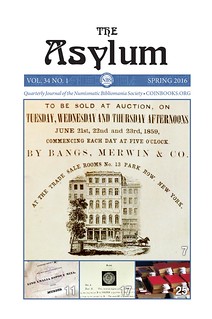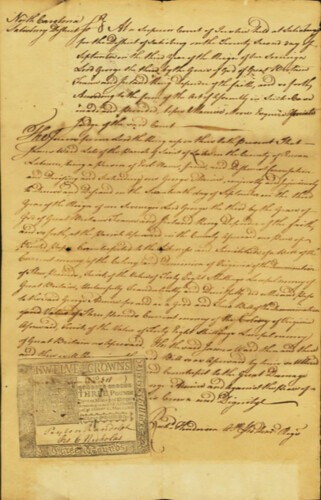
About UsThe Numismatic Bibliomania Society is a non-profit organization devoted to the study and enjoyment of numismatic literature. For more information please see our web site at coinbooks.org SubscriptionsThose wishing to become new E-Sylum subscribers (or wishing to Unsubscribe) can go to the following web page link MembershipThere is a membership application available on the web site Membership Application To join, print the application and return it with your check to the address printed on the application. Membership is only $20 to addresses in the U.S., $25 for First Class mail, and $30 elsewhere. For those without web access, write to: Terry White, Treasurer
AsylumFor Asylum mailing address changes and other membership questions, contact Terry at this email address: terrywhite5475@yahoo.com SubmissionsTo submit items for publication in The E-Sylum, just Reply to this message, or write to the Editor at this address: whomren@gmail.com BUY THE BOOK BEFORE THE COINSale Calendar |
- WAYNE'S WORDS: THE E-SYLUM APRIL 3, 2016
- ASYLUM EDITOR DAVID YOON MOVES ON
- MARIA FANNING ASSUMES ASYLUM EDITORSHIP
- KOLBE & FANNING ONLINE SALE CLOSES APRIL 16, 2016
- NEW BOOK: THE ARMCHAIR GUIDE TO COINS
- MAGAZINE REVIEW: SCULPTURE REVIEW ON RELIEF
- NEWMAN PORTAL ADDS E-PUBLICATIONS
- THOMAS LINDSAY ELDER (1874-1948)
- USING NUMISMATIC PROVENANCE AS BUYER PROTECTION
- ANS RECEIVES GRANT TO CLEAN U.S. LARGE CENT COLLECTION
- GERALD TEBBEN LOOKS AT THE RED BOOK
- NOTES FROM E-SYLUM READERS: APRIL 3, 2016
- ENGRAVED "HOBO STYLE" VICTORIA YOUNG HEAD PENNIES
- YOUNG NUMISMATISTS AND NUMISMATIC MULTIMEDIA
- THE SAN FRANCISCO MINT ROBOTS
- MORE ON THE 1974-D ALUMINUM CENT LAWSUIT SETTLEMENT
- COLONIAL COUNTERFEITERS OF EVIL NAME AND FAME
- JEWISH-AMERICAN HALL OF FAME GERTRUDE BERG MEDAL
- LIBERTY PORTRAIT RECOMMENDATION DRAWS CRITICISM
- LIBERTY DOLLAR CREATOR VON NOTHAUS ISSUES "TRUMP DOLLARS"
- WAYNE'S NUMISMATIC DIARY: MARCH 31, 2016: PART 1
- WAYNE'S NUMISMATIC DIARY: MARCH 31, 2016: PART 2
- WAYNE'S NUMISMATIC DIARY: MARCH 31, 2016: PART 3
- ROYAL MINT REDEFINES LEGAL TENDER FOR COMMEMORATIVE COINS
- WOMEN AND LABOR ON PAPER CURRENCY
- SCOTTISH BANKNOTES OFFERED BY PAM WEST
- UKRAINE INTRODUCES MONEY MADE OF FLAX
- NANO-HOLES FOR BANKNOTE SECURITY
- LABORATORY ANALYSIS OF STOLEN CURRENCY
- AN OTTOMAN COIN EMBOSSED POSTCARD
- PUNCH-MARKED COINS IN INDIA
Click here to access the complete archive
To comment or submit articles, reply to whomren@gmail.com
WAYNE'S WORDS: THE E-SYLUM APRIL 3, 2016
New subscribers this week include: Mark Tabb, courtesy of Mark Ferguson; Joe Pargola, and Frank Cooper. Welcome aboard! We now have 1,961 subscribers.
Welcome also to new advertiser Gerry Fortin. Gerry's article on numismatic provenance in The Gobrecht Journal #125 is republished in this issue.
This week we open with updates from NBS on editorship of our print publication The Asylum, a new Kolbe-Fanning sale, one new book and one review.
Other topics this week include Tom Elder, numismatic provenance and 'coin doctoring', young numismatists and multimedia, robots at the Mint, 'Trump Dollars', Scottish banknotes, and money made of flax.
To learn more about The Armchair Guide to Coins, bas-relief, the Howard Gibbs files, a CARFAX-like numisamatic database proposal, and colonial counterfeiters of evil name and fame and dishonest conversation, read on. Have a great week, everyone!
Wayne Homren
Editor, The E-Sylum

ASYLUM EDITOR DAVID YOON MOVES ON
With mixed feelings, I have to announce that this is the last issue of The Asylum for which I will serve as managing editor. When I began in 2007, I was working mostly as an editor, and the other work that I had left me enough free time to fit in The Asylum four times a year without much difficulty. However, I have since accumulated other roles and other work projects, both numismatic and archaeological, and it is increasingly difficult for me to spare the time to work on The Asylum. With partial responsibility for three excavation reports plus two or three other major projects in the queue, something had to go. As a result, I decided a few months ago to submit my resignation as managing editor to the NBS Board.
However, despite the practical necessity for this change, I will miss working with the many talented and helpful members of the NBS who have made my editorial work so interesting, educational, and enjoyable. I am very grateful to all who have submitted articles during the past several years, who uncomplainingly accepted my editorial interventions and almost always answered queries and checked proofs more promptly than I had any right to expect.
In addition to all the writers, I have to thank the people who have made my task of finding articles and turning them into a finished product so much easier. Producing a publication like The Asylum is very much a team effort; my thanks go to all those who have helped behind the scenes in many ways, including the late Rick Witschonke as well as John Adams, Joel Orosz, David Sundman, George Kolbe, Bob Leonard, Liz Benge, Lisa McCullough, Terry White, and especially Wendy Joseffy.
Fortunately, the NBS has found a very skilled replacement for me: Maria Fanning, whose excellent work on Kolbe & Fanning catalogues will be familiar to many of you. I have updated the contact information at the back of this issue to reflect the new editorship. Maria will take over the e-mail address that I set up for use as editor of The Asylum: nbsasylum@gmail.com. For traditional postal mail, Maria can be reached at Kolbe & Fanning:
Maria Fanning, Editor, The Asylum
141 W. Johnstown Rd
Gahanna, OH 43230
(614) 414-0855
I am not leaving the world of numismatics, and I expect I will continue to work with many of you in connection with other numismatic projects. For the future, I can be reached at my American Numismatic Society e-mail: dyoon@numismatics.org.
Elizabeth Hahn Benge will be continuing in her role as Editor-in-Chief during this transition. I hope you will support Liz and Maria with an abundance of new articles to keep The Asylum full of exciting, entertaining, and important new research, commentary, and ponderings on numismatic literature and the history of numismatics during the years to come.
David Yoon
MARIA FANNING ASSUMES ASYLUM EDITORSHIP
- The John K. Curtis Auction of June 21st 1859 by P. Scott Rubin
- A Walk on the (Literary) Wild Side with William E. Dubois by Joel J. Orosz
- Off the Shelf: Newcomb’s Book on the Cents of 1801-03 by David F. Fanning
- Behind the Scenes at the Newman Numismatic Portal by Len Augsburger
From the Editor
by Maria Fanning
NBS members will soon be receiving the first issue of The Asylum that I have had the pleasure of editing. Many of you may know me through my work at Kolbe & Fanning Numismatic Booksellers and may have met me at the ANA’s World’s Fair of Money, the New York International Numismatic Convention or through email correspondence. I am pleased to be succeeding David Yoon, who has continued to produce an impressive publication for the past nine years. He has graciously offered his support and assistance in my first few issues and I thank him for leaving me with a vibrant journal. I know we all wish him the best for the future, be it in numismatics or archaeology!
The Asylum has a long history of being a hub of research and discussion for those serious about their love of numismatics. I hope to draw on that passion to include even more contributions from those we have not yet heard, as well as our excellent regular contributors. There is plenty of room for those with a scholarly bent as well as inexperienced writers with a passion for numismatic books and we want to hear about yours.
We have some fascinating articles in this issue. We are very lucky to have an article by P. Scott Rubin on his 19th-century auction catalogues, which we hope will become an ongoing series. We also have a spicy tale of love and murder written by no other than famed Mint Director William E. Dubois and brought to light by our own Joel Orosz. David Fanning shares another of his award-winning “Off The Shelf” columns, this one on Newcomb’s book on 1801-03 cents, and Len Augsburger gives us an exciting update on what’s happening with the Newman Portal.
To get to know you all better I have put together a brief 10-question multiple-choice survey about your collecting and reading interests. I hope that you will indulge me for a few minutes so that I can tailor content to what you want most to read. My ulterior motive is also to collect information on our readers’ specific areas of interest and collecting habits to share with potential advertisers and help expand and improve our journal. You can take the survey at https://www.surveymonkey.com/r/N295ZKS. Information will be kept anonymous. Your input is much appreciated!
I am excited to meet all of our readers, whether in person or by email, and would love to hear from all of you. If you have an idea for a submission, please let me know as soon as possible so we can fit it into our editorial calendar. Please feel free to contact me at nbsasylum@gmail.com at any time with suggestions or contributions for future issues. The deadline for the next issue will be May 1. Happy reading!
Maria Fanning
NBS Treasurer Terry White adds:
If you received a renewal envelope in the latest of The Asylum your dues are now past due.
To participate in Maria's Asylum survey, see: https://www.surveymonkey.com/r/N295ZKS
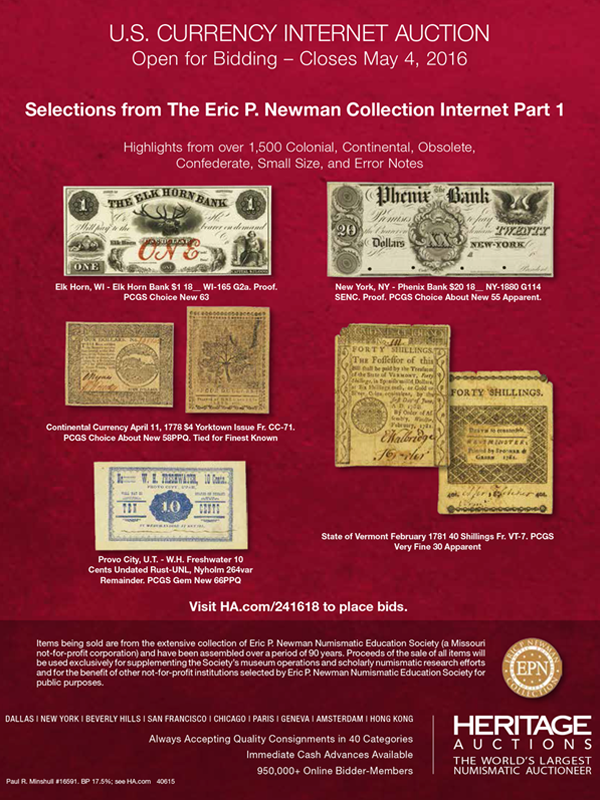
KOLBE & FANNING ONLINE SALE CLOSES APRIL 16, 2016

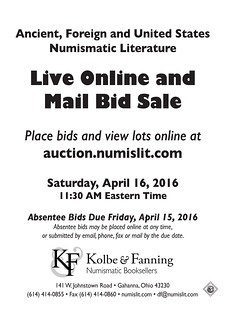 Kolbe & Fanning Numismatic Booksellers have announced that their next online numismatic book auction has been posted, and that bidders may
browse the sale’s contents through the firm’s online bidding portal at auction.numislit.com. The sale will take place on Saturday, April 16,
beginning at 11:30 a.m., eastern time.
Kolbe & Fanning Numismatic Booksellers have announced that their next online numismatic book auction has been posted, and that bidders may
browse the sale’s contents through the firm’s online bidding portal at auction.numislit.com. The sale will take place on Saturday, April 16,
beginning at 11:30 a.m., eastern time.
The April 16 auction is the latest in Kolbe & Fanning’s series of smaller online numismatic book auctions held by the firm in addition to their traditional printed-catalogue sales and public auctions. This sale includes a wide variety of material, covering ancient, medieval and modern foreign, and U.S. numismatics, and features 400 lots ranging in estimated value from $20 to $400. All lots are illustrated and feature the full descriptions collectors have come to expect from Kolbe & Fanning.
A few sale highlights include:
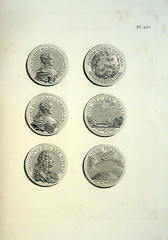 Sambon’s 1885 auction sale of the Amilcare Ancona collection, with three photographic plates (lot 80)
Sambon’s 1885 auction sale of the Amilcare Ancona collection, with three photographic plates (lot 80)
A set of Mattingly et al.’s Roman Imperial Coinage including first editions (with superior collotype plates) of eight of the volumes (lot 74)
The six volumes comprising the complete Hunt Brothers collection of Greek, Roman and Byzantine coins (lot 87)
Mechel’s exceptional 1776-1778 work on the medallic work of the Chevalier Hedlinger (lot 162)
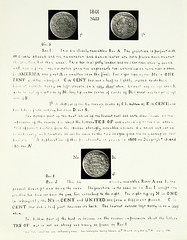 An original set of Tentzel (1705-13) on the coins of Saxony (lot 207)
An original set of Tentzel (1705-13) on the coins of Saxony (lot 207)
Lester Merkin’s copy of Newcomb on the U.S. large cents of 1801-1803, with both supplemental plates (lot 320)
An original volume from the American State Papers on finance, covering the years 1802-1815 and providing much information on the U.S. Mint and related history (lot 385).
The online sale is available now for browsing and absentee bidding at auction.numislit.com. A PDF of the catalogue can be downloaded for the convenience of the reader through the firm’s regular website at numislit.com.
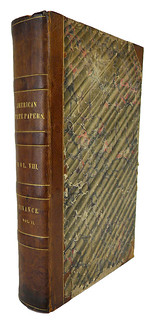 Although billed as an “online sale,” bidders may participate in the April 16 sale in a variety of ways: regular mail, email, phone, fax or
online bidding (live or absentee). Any absentee bids must be received by the day before the sale (April 15) in order to give us time to enter them.
Advance bids may be placed directly online at any time prior to the lot being sold. On Saturday, April 16, beginning at 11:30 A.M. eastern
time, the sale will be conducted as a live internet auction.
Although billed as an “online sale,” bidders may participate in the April 16 sale in a variety of ways: regular mail, email, phone, fax or
online bidding (live or absentee). Any absentee bids must be received by the day before the sale (April 15) in order to give us time to enter them.
Advance bids may be placed directly online at any time prior to the lot being sold. On Saturday, April 16, beginning at 11:30 A.M. eastern
time, the sale will be conducted as a live internet auction.
Customers who have participated online in any of Kolbe & Fanning’s sales will be familiar with the process. Others are encouraged to set up an iCollector account through auction.numislit.com and see for themselves how easy it is. Bidders wishing to participate in the live sale are strongly encouraged to register in advance.
Any questions may be directed to David Fanning at df@numislit.com or by phone at (614) 414-0855. We look forward to your participation.
To view lots and place bids, see:
http://auction.numislit.com/
To download the catalog PDF, see:
http://www.numislit.com/dl.php?file=/images/upload/041616kfsale.pdf&type=pdf
NEW BOOK: THE ARMCHAIR GUIDE TO COINS
The Armchair Guide to Coins
by Aprille Foole
An announcement of a new book specially for 1st April.
A collector’s guide to coins found down the back of sofas and other furnishings. It is written by a leading expert who holds a chair at a well known university. This is an historical review of the coins found down the back of furniture.
Features:
- The ancients – and the reclining couch. The Romans were party people and sometimes dropped a denarius or two down the back of a couch.
- Swedish plate money found in flat pack / self-assembly furniture.
- Early colonial minimalist chairs and tables
- The very rare Titanic “deckchair” hoard.
Also what else to find; such as pencils, pens, magazines, fluff, pets, and sweets.
Builds on the major texts in other languages:
L ’amour et le chaise longe in French
Das settee und Pfenningsindemsofa in German.
If you want to pre-order a copy check the date.

MAGAZINE REVIEW: SCULPTURE REVIEW ON RELIEF
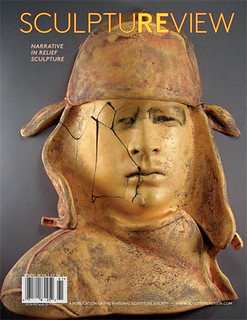 Question: What type of art is required of models for coins and medals?
Question: What type of art is required of models for coins and medals?
Answer: Relief. Sculpture Review in their issue out this week (Spring 2016) devotes the entire issue to relief. The term is also called “bas-relief” by sculptors preparing models (the “s” is silent). For numismatists this is the device and lettering the entire surface on one side of a coin or medal.
The bi-monthly magazine of glyptic art’s keystone article notes the vast scope of relief from hand-held medals to multi-story architectural motifs. It is illustrated by a dozen of these and David Smith's 10 3/8-inch Medal of Dishonor.
Six articles follow, first of which is an interview of master medallist Eugene Daub, who reveals his views of this special art plus review of four medallists he admires. This is illustrated by the wide use of medallic compositions, gem stones to polychrome figures, the multitude of shapes and fabrication. In addition a conventional medal or two is shown.
Two articles by Wolfgang Mobry discuss the narrative and the liner form of relief objects. Cory Gillilland's article covers FIDEM, the international medal art organization, illustrated with a wide variety of medallic art exhibited at their bi-annual exhibitions.
Artist and New York medallic promoter Mashiko highlights medallic art worldwide by notable works by artists from eleven countries. In addition to unusual shapes these exhibit patinas in medallic colors in her article titled “The Fascination of Medallic Art.”
Anyone interested in art medals should get a copy of this issue -- for the excellent illustrations alone! Contact National Sculpture Society either at their website or 75 Varick Street, 11th Floor, New York, NY 10013. Single copy price $6.95. (If that address sounds familiar, it is also the address of American Numismatic Society, they share the 11th floor.)
To visit the National Sculpture Society web site, see:
http://nationalsculpture.org/
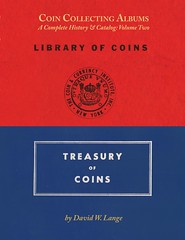
Pre-Publication Offer Until May 1, 2016
Coin Collecting Albums
A Complete History & Catalog: Volume Two
$45 plus $10 for priority shipping
David W. Lange, POB 110022, Lakewood Ranch, FL 34211, langedw@msn.com
NEWMAN PORTAL ADDS E-PUBLICATIONS

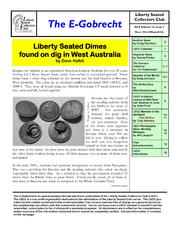 In addition to scanning numismatic literature, the Newman Portal incorporates publications already in electronic form. The recently added
The E-Gobrecht, a monthly e-publication of the Liberty Seated Collectors Club, has been issued by Editor Bill Bugert since 2005, and includes
a mix of club news, auction results, and research articles.
In addition to scanning numismatic literature, the Newman Portal incorporates publications already in electronic form. The recently added
The E-Gobrecht, a monthly e-publication of the Liberty Seated Collectors Club, has been issued by Editor Bill Bugert since 2005, and includes
a mix of club news, auction results, and research articles.
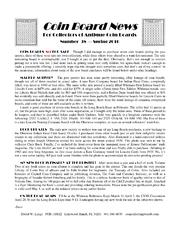 David Lange’s Coin Board News is another e-publication, periodically issued since 2008 and containing research and market
information on antique coin holders.
David Lange’s Coin Board News is another e-publication, periodically issued since 2008 and containing research and market
information on antique coin holders.
To have your e-publication included in the Newman Portal, please contact Project Coordinator Len Augsburger at leonard.augsburger@wustl.edu.
To read the The E-Gobrecht on NNP, see:
http://www.newmanportal.org/library/publisherdetail/511326
To read Coin Board News on NNP, see:
www.newmanportal.org/library/publisherdetail/511428
THE BOOK BAZARRE
THOMAS LINDSAY ELDER (1874-1948)
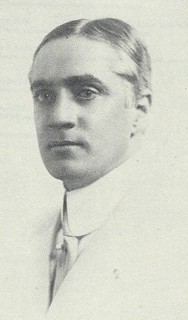 Thomas Lindsay Elder (1874-1948), born at Dayton, Pennsylvania, on November 22, 1874, son of Scottish-American parents, McLeod and Hannah
(Knox) Elder.
Thomas Lindsay Elder (1874-1948), born at Dayton, Pennsylvania, on November 22, 1874, son of Scottish-American parents, McLeod and Hannah
(Knox) Elder.
Thomas Elder is among the most prominent and influential American numismatists and coin dealers of the first three decades of the 20th century up to the early 1930's when other prominent dealers like B. Max Mehl, Wayte Raymond, Joe and Morty Stack, emerged dominating the market overshadowing him.
He began collecting tobacco tin tags at age eight in 1882 and coins at thirteen in 1887 when living in Bethlehem, Pennsylvania. For the uninitiated collecting tobacco tin tags was a widespread hobby much like cigar band collecting or tobacco tin collecting in America and in Europe and was a typical feature published in The Golden Argosy; The Oologist; The American Magazine of Natural Science; Mineralogist's Monthly; and Philatelic West and other collecting periodicals during the 1880's and 1890's. In his lifetime of collecting his favorite pieces were store cards, tokens, medals and political pieces.
He studied at Park Institute and Beaver College.
From 1899 to 1901 he lived at 343 Princeton Place, Pittsburg, Pennsylvania; (April 1902 The Numismatist) 843 Princeton Place, E.E., Pittsburg, Pennsylvania; (Station A, Pittsburg, Pennsylvania).
His first ad in the September 1899 issue of The Numismatist, pages 207-8, was an announcement for his eight-page fixed priced list of ancient and medieval coins and served as a notice for his small display ad forthcoming in the November issue for Greek, Bactrian, Parthian, Egyptian, Roman, Byzantine, and medieval British and French coins. A similar but larger size ad appeared in the January 1900 issue on page 33.
He got his feet wet writing in The Numismatist in the February 1901 issue describing five medals in his collection and inquiring further information about the Palmetto "No submission" token. B. P. Wright replied in the April issue correcting him about the attribution, and also about the Pitt medal. Also, he wrote a series "Notes on the Coinage of the Greeks,” in The Philatelic West. By late fall through December 1901 his second series titled “Money in Circulation in America in Colonial Times,” was also published in Philatelic West.
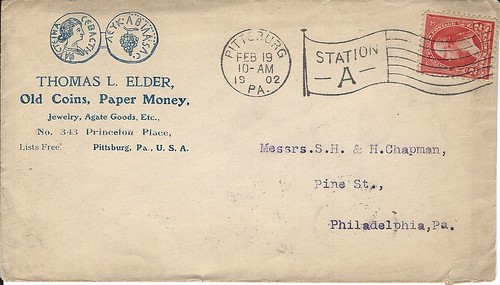
In June of 1902 he lived at 238 Sheridan Avenue, Pittsburg (stamped on his aluminum store card, and on his printed business envelopes) and this new address was published in the July issue of The Numismatist, and also appears on his new printed business envelopes that refer to his corporate name as Thomas L. Elder, Importer of Ancient, Medieval and Modern Coins, Inc. Also, another envelope, Thomas L. Elder, Dealer in Ancient, Mediaeval and Modern Coins, Paper Money, Gem Stones, Curios, Etc. 238 Sheridan Ave., Pittsburg, Pa. Price List Free.
In May 1904 he moved to 32 East 23rd Street, New York City, NY, and later on at 8-10 W. 37th Street, New York. He spent thirty-five years in New York before retiring to South Carolina.
He was an active member of the ANS since January 18, 1904. By 1906 he served on the ANS committee to improve the artistic design of American coinage which met with President Theodore Roosevelt.
Elder always seemed to show a dark side to his character which seemed to grow stronger from 1906 to 1909, like a blister that swelled up and burst. Dave Bowers rightly called his writing "feisty and irreverent" in his seminal article in Rare Coin Review (Winter 1988) : 59-62; John W. Adams, "One might accuse Elder of being short-tempered, sharp-tongued or self-righteous but never dull or dishonest." U.S. Numismatic Literature, Vol. 2, page 25; and Pete Smith aptly called him "Opinionated and Outspoken" in The Numismatist (2000) : 399-400.
In the 1906, besides publishing his monthly periodical, fixed price coin lists, and other circulars, flyers and business letterheads, invoices, envelopes and post cards he ran The Elder Numismatic Press publishing numismatic literature including : William Cowper Prime, Money of the Bible (1906); Ed Frossard, W W Hays, and Thomas L Elder, Varieties of United States Cents of the Year 1794 (1910); Frank C Higgins, The Chinese Numismatic Riddle; The Elder Rare Coin Book (1913); Ebenezer Gilbert, The United States Half Cents. From the First Year of Issue, in 1793, to the Year When Discontinued, 1857. All Dates and Varieties Described and Illustrated (1916); ...
He was among the "dirty dozen" founders of The New York Numismatic Club on December 11, 1908, at Keen's Old English Chop House located on 36th and 6th Avenue. These were all die-hard numismatists and collectors each one a notable figure critical to the history of American numismatic history.
From 1914 to 1916 Elder might have been instrumental in influencing the U. S. Mint designers A. A. Weinman and Herman A. MacNeil in their new designs for the dime, quarter and half dollars, but this claim may very well be an exaggeration.
By January 1937 he was desperate to close the Elder Coin & Curio Corporation and ran an ad very anxiously hoping to find someone to buy him out and take over the company. But there were no takers and he was forced to close.
He died, as John W. Adams has put it, "a sick and cynical old man" on May 11, 1948, at Travelers Rest, South Carolina, about 9 miles north of Greenville. An obituary appeared in the June issue 1948 of Hobbies Magazine, on page 131. His obituary did not appear in The Numismatist until July and with a scanty obituary notice.
The career of Thomas L. Elder may rightly be described as coming in like a roaring lion and having gone out in a very faint whisper, or was it a whimper. Perhaps his best epitaph was written by John W. Adams, "He could cause the fur to fly but none could doubt his sincerity and, in the end, few can match the breadth of his contributions." U.S. Numismatic Literature, Vol. 2, page 25.
The inventory left by Elder purportedly was taken over by his son-in-law, Paul S. Seitz (1902-1978), a bank bookkeeper, who traded out of Glen Rock, Pennsylvania, and in time became well-known as a respectable dealer. Seitz's wife was Ethel K. Seitz (1903-1995). The earliest known marriage of Thomas L. Elder was in 1908, five years after the birth of Ethel. Seitz was related to Elder through his mother Lydia May Seitz (1887-1937), and was not his son-in-law.
To read the complete article, see:
ELDER,
THOMAS LINDSAY
(https://sites.google.com/site/numismaticmallcom/encyclopedic-dictionary-of-numismatic-biographies/elder-thomas-lindsay)
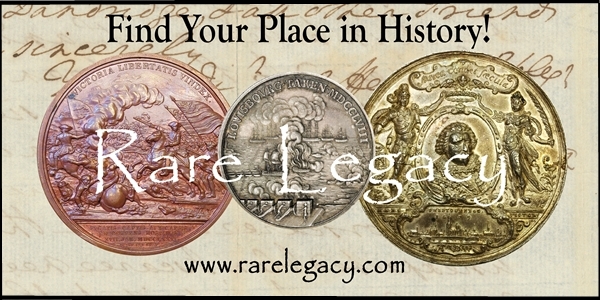
USING NUMISMATIC PROVENANCE AS BUYER PROTECTION
Using Numismatic Provenance as Buyer Protection
by Gerry Fortin, LSCC #1054
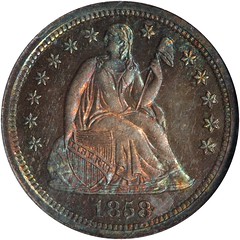 Assembling an advanced collection of Liberty Seated coinage requires substantial patience, considerable searching, financial resources and
of course, plain old luck. Many of the quality coins in today's market that are naturally original with eye appeal are presently graded and
encased in Third Party Grading (TPG) service holders. Certified Acceptance Corporation (CAC) provides an incremental evaluation layer for coins in
existing TPG holders. The numismatic market has matured during the last 15 or so years with substantial improvements in buyer protection.
Assembling an advanced collection of Liberty Seated coinage requires substantial patience, considerable searching, financial resources and
of course, plain old luck. Many of the quality coins in today's market that are naturally original with eye appeal are presently graded and
encased in Third Party Grading (TPG) service holders. Certified Acceptance Corporation (CAC) provides an incremental evaluation layer for coins in
existing TPG holders. The numismatic market has matured during the last 15 or so years with substantial improvements in buyer protection.
Coin doctoring, enhancements or restoration remains an ongoing issue in our hobby. The "doctors" are individuals who are motivated by greed. These individuals possess expertise in modifying the surface characteristic of copper, silver and gold coins towards securing higher TPG certified grades. In some cases, the doctors will restore coins previously designated as cleaned or impaired by the TPGs in the hopes of receiving normal certification upon resubmission. In all cases, the doctors seek quick financial gains by securing a grade improvement and therefore sales potential at a higher level than their purchase prices. These coins are typically sold to unsuspecting dealers or consigned to the auction houses.
The TPGs are constantly challenged with doctored coin submissions that may be discretely included in larger submission lots. Since the grading service offer a buyback guarantee for their certified opinions, then vigilance for flagging and rejecting doctored coins is ongoing. A dark side of our hobby involves this constant gamesmanship between the coin doctors and the grading services. There are cases where the restorations or surface modifications are so well performed, that coins will be certified.
A recent case involving a five figure Liberty Seated coin minted at Carson City purchased by an LSCC member crystallized this issue for me. I was contacted, as LSCC President, for advice and help towards resolving a situation where a previously NCS certified coin as cleaned was professionally restored and certified by one of the leading TPG services. Personal inspection of the coin validate the capabilities of the coin doctor to remove all traces of the prior cleaning resulting in surfaces that appeared to be strictly original and attractive.
Even with my own 25 years of collecting, and now dealing in Liberty Seated coinage, the workmanship would have fooled me 10 out of 10 times. This event brought about the realization that collectors must do more than simply trust the TPG certifications when spending substantial sums on key date Liberty Seated coins. The TPG services are not to be faulted in any way during this article as the TPG service encapsulating the doctored Carson City did honor their buyback guarantee. This is positive news for collectors and our hobby.
The used car market has always been an area of caution as mechanical problems can be hidden and not appear until after the purchase warranty period expires. CARFAX.com and its massive database for recording individual ownership, servicing and accident repair records has dramatically improved the used car buying process. Armed with a car's ownership and repair history, buyers are in a much better position to make educated decisions concerning potential risks for subsequent failures and repair costs. No one wants to buy a "lemon" right?
The CARFAX methodology would be a useful tool in the numismatic hobby to lower buyer risks for doctored coins. This type of information system is not available today though the online auction records of major auction houses do provide substantial information for coins sold in the last 20 years. As an alternative, buyers of key date coins that come with high price tags should carefully research the provenance of the targeted coin. Wikipedia defined "provenance" as the chronology of the ownership, custody or location of a historical object. The primary purpose of tracing the provenance of an object or entity is normally to provide contextual and circumstantial evidence for its original production or discovery, by establishing, as far as practicable, its later history, especially the sequences of its formal ownership, custody and places of storage.
When spending five or six figures on an important numismatic property, I would recommend that buyers ask questions as to the pedigree and TPG certification for that property. Understanding the prior ownership sequence would lower risk and bring peace of mind concerning future resale value. The lack of ownership records raises a flag that caution may be warranted and that it might be a good idea to do some careful due diligence before purchasing the coin. Coins that reside in old TPG holders, for example, PCGS rattler and old green label holders can be immediate vetted in terms of their preservation state during the last 25 years or so. The same is true for coin encapsulated by NGC in early "fatty" holders and for ANACS graded coins in their small white holders. High priced coins in recent 2014 or 2015 generation PCGS or NGC holders are candidates for a provenance investigation before purchase since the coins have been recently graded.
In summary, as with any collectible, buyer knowledge and due diligence are paramount for making wise purchase decisions. Purchasing coins by using logical evaluation rather than emotions is advised. The development of a CARFAX equivalent numismatic database for key date coins would be a well founded initiative towards assembling buyer protection information. Researching pedigrees and ownership sequence is time consuming and beyond the capabilities of many dealers and certainly buyers. I don't see for profit companies in the numismatic industry investing in a provenance database and hope to be proven incorrect. Non profit organizations, with the vested interests of their sponsors or membership, could take on a project of this magnitude.
The number of five and six figure key date coins when certain design series and denominations is limited when compared to the entire numismatic market. Mapping the provenance of a small subset of coins with photographs and ownership records would be a substantial step forward for buyer protection while placing pressure on the coin doctors to terminate their operations or shift their focus elsewhere. Reducing the number of important coins being tampered with by making it difficult to reap profits would be the overriding goal coupled with buyer protection.
I recognize that this brief essay may be viewed as being controversial by some in the numismatic industry. My intentions are genuine as a life long collector and as an individual that has a fond appreciation for historical artifacts. During our lifetimes, I believe that we are only curators and have the responsibility to care for our coins in a manner that preserves their integrity for future generations.
Coins lack serial numbers but do have certain diagnostics that could help uniquely identify them. But it's a never-ending battle as old as the hobby itself. If provenance becomes the new gold standard, then the doctors will turn to inventing plausible provenances, further muddying the numismatic research landscape.
Another dimension of this story is the fine line between "curation" and "doctoring". Where does one end and the other begin? And if in the end a highly qualified and experienced specialist can't tell the difference, does it matter? Isn't that a definition of success? What do readers think? -Editor
For more information on the Liberty Seated Collectors Club, see:
www.lsccweb.org
ANS RECEIVES GRANT TO CLEAN U.S. LARGE CENT COLLECTION
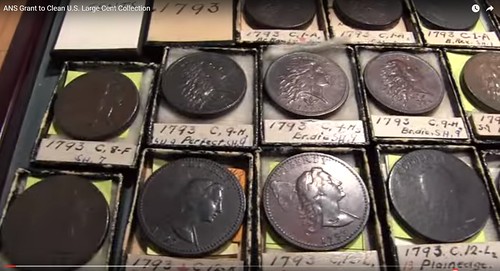
The ANS is pleased to announce today that it has received a Rockefeller-Noggin grant that will be used to conserve its important collection of early U.S. large cents. After decades of neglect, dust dirt and grime have taken their toll on this part of our collection. This results in a a layer of corrosion, tarnish and oils that cause the once brilliant gleaming coin to have a dull dark brown appearance making photography of these items very difficult. The ANS photographer, Alan Roche, took the initiative to apply for a grant from the prestigious Rockefeller-Noggin Institute to restore the coins to their original lustre. The successful application means the Society will receive $20,000 in funding to hire personnel and purchase conservation materials, including 50 gallons of Brasso™, to conserve approximately 10,000 coins. The work is to commence immediately.
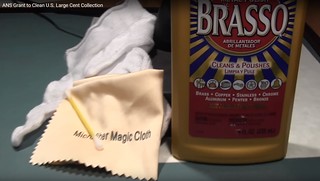
To read the complete article, see:
ANS RECEIVES GRANT TO CLEAN U.S. LARGE CENT COLLECTION
(www.anspocketchange.org/grant-to-clean-large-cents/)

GERALD TEBBEN LOOKS AT THE RED BOOK
Red Book 70th Anniversary: A Look Back
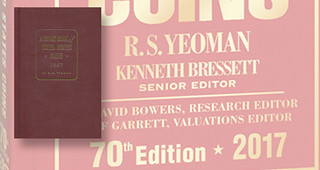 A Guide Book of United States Coins by R.S. Yeoman, the venerable “Red Book,” enters its well-deserved 70th edition this year. The
1946 foundation was strong and durable; every edition since has stayed true to its basic format – a retail price guide and numismatic primer.
A Guide Book of United States Coins by R.S. Yeoman, the venerable “Red Book,” enters its well-deserved 70th edition this year. The
1946 foundation was strong and durable; every edition since has stayed true to its basic format – a retail price guide and numismatic primer.
It remains inexpensive, accessible and definitive.
Readers over the decades learned not only the current price of the coin they were interested in, but a bit of its history and, in some cases, the rationale for producing it. First editor Yeoman was as much interested in the educational aspects of collecting as the financial.
The book has served an astounding four generations of collectors. And while its print run is diminished from its all-time high of 1.2 million in 1965, it remains true to its origins and delivers an ever-improving product to collectors year in and year out.
The Red Book is an incredible first point of contact for most collectors. People who pick up an odd coin in circulation or stumble across a tin can of gold go to it first to figure out what they’ve got and what it’s worth. The book whets the appetite of the curious and encourages them to explore the hobby further.
During the next five weeks, I’m going to look at five changes in the book over the years, some typographical, some based on new scholarship, all changes that made the book a better product or serve as a marker for collectors of the books themselves.
Red Book 70th Anniversary: The 1903-O Morgan Silver Dollar
 The 1903-O is an incredibly important coin in the history of Morgan dollar collecting. From its minting to the early 1960s, it was the star
of the series. Q. David Bowers estimates, in his Silver Dollars & Trade Dollars of the United States: A Complete Encyclopedia, that fewer than 10
uncirculated pieces were known before October 1962, when the Treasury Department released bags and bags of them.
The 1903-O is an incredibly important coin in the history of Morgan dollar collecting. From its minting to the early 1960s, it was the star
of the series. Q. David Bowers estimates, in his Silver Dollars & Trade Dollars of the United States: A Complete Encyclopedia, that fewer than 10
uncirculated pieces were known before October 1962, when the Treasury Department released bags and bags of them.
Bowers estimates 200,000 or more uncirculated 1903-O dollars exist today. Before the Treasury release, the coin cataloged for $1,500, more than any other Morgan. The price fell off a cliff in 1963, dropping as low as a reported $7. Today the coin lists in Coin World’s Coin Values at $450 in MS-63. The value and the demand for the coin are in no small part based on its fabled history.
The coin also serves as a way to distinguish the rare first print run of the first edition of A Guide Book of United States Coins from the more common second printing.
In November 1946, 9,000 copies of the 1947-dated Red Book were printed. A paragraph below the Morgan dollar listing ambiguously reads, “270,232,722 silver dollars were melted under the Pittman Act of April, 1918, 259,121,554 for export to India, and 11,111,168 for domestic subsidiary coins, which probably accounts for the scarcity of this date.”
In February 1947, an additional 22,000 copies were printed to meet unexpectedly strong demand for the title. The Morgan dollar paragraph was altered to eliminate the ambiguity. The ending phrase “scarcity of this date” was changed to “scarcity of 1903 O.”
To read the complete article, see:
RED BOOK 70TH ANNIVERSARY: A LOOK BACK
(www.coinworld.com/voices/gerald-tebben/2016/03/red_book_70th_annive.html)
To read the complete article, see:
RED BOOK 70TH ANNIVERSARY: THE 1903-O MORGAN
SILVER DOLLAR (www.coinworld.com/voices/gerald-tebben/2016/03/red_book_70th_annive1.html)
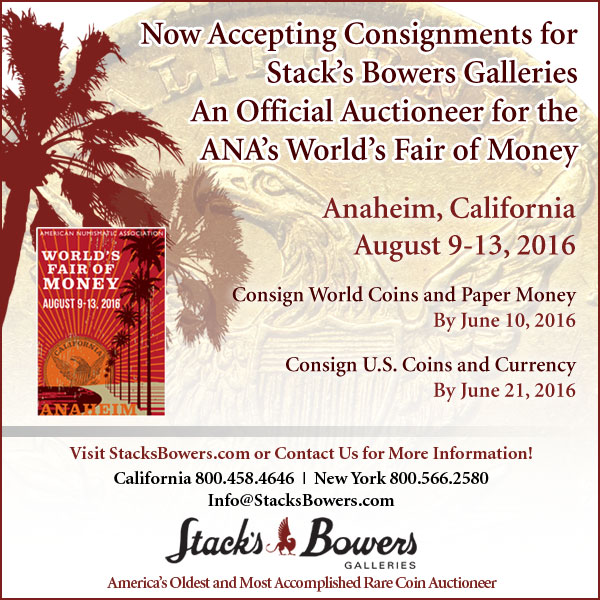
NOTES FROM E-SYLUM READERS: APRIL 3, 2016
Reader Compliments
Yossi Dotan writes:
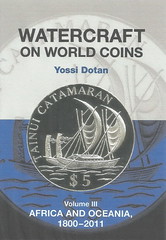 I read your review of my book Watercraft on World Coins as a reader of The E-Sylum and I want to thank you for writing the
review and for your congratulations and compliments. You captured nicely the essence of the book without repeating the earlier presentation of this
volume in v18n45a03.
I read your review of my book Watercraft on World Coins as a reader of The E-Sylum and I want to thank you for writing the
review and for your congratulations and compliments. You captured nicely the essence of the book without repeating the earlier presentation of this
volume in v18n45a03.
I have much appreciation for the fact that you are compiling The E-Sylum for almost twenty years and making it a worthwhile read for almost 2,000 numismatists on a weekly basis. I know you stretch the work over an entire week, and most of each issue is written by readers, but even though, sending out drafts, getting comments, dealing with them, it all adds up to a lot of work for each and every issue, besides your family and your work. Really amazing doing that for so long a period!
To read the earlier E-Sylum article, see:
BOOK REVIEW: WATERCRAFT ON WORLD COINS, VOLUME III
(www.coinbooks.org/esylum_v19n13a07.html)
Remembering Steve Tanenbaum
Pete Smith writes:
I was watching television when the E-Sylum arrived on Easter Sunday night, March 27, 2016. I realize that television schedules are different around the country. The show I was watching was called "Killing Spree" on The Justice Network.
I looked up from my computer screen to the television screen. There was a brief picture of Steve Tanenbaum, victim of a spree killer and hit-and-run driver.
It is very unusual to see a friend on a national television show. I wonder if any other E-Sylum readers caught the show.
To read the earlier E-Sylum articles, see:
DEALER STEVE TANENBAUM FELLED BY KILLER IN NEW YORK RAMPAGE
(www.coinbooks.org/esylum_v14n07a02.html)
MORE ON DEALER STEVE TANENBAUM (www.coinbooks.org/esylum_v14n08a07.html)
Steve D'Ippolito's Numismatic Origin Story
Steve D'Ippolito submitted his numismatic origin story:
I'll go ahead and date myself. I was six years old in 1970, had become aware of numbers, and one could still get cents from the 1940s in change. Probably about ten percent of cents were wheaties, My parents had a little bowl of cents, and they'd let me go through them and put them in a blue Whitman folder. I think my oldest find was a 1919 (I don't recall the mint mark). From there it was on to bigger and better things but always on an extreme budget, I doubt I ever had anything worth more than $20. (I beat that 1919 find relatively recently by finding a 1926...yes, it's seven years newer but I found it forty-plus years later.)
I lapsed from the hobby in high school and college, then a couple years after college my collection got stolen. Once I finished moving back to Colorado, I resolved to rebuild the collection, better than it was before. I spotted a 1909 polushka (quarter kopek) on the Hallenbeck bid board sometime in 1990 and that eventually oriented me towards Russian imperial--I became full time on that in 1996. I got into exhibiting in 1998. 2008 marked the official end of Russian Imperial for me as I sold the collection, having won three Howland Wood awards in a row with it. I've done some ancients since then, and some US paper, but my main focus right now is a US type set, 1800-1964 (excluding gold).
To read the earlier E-Sylum articles, see:
HOW DENNIS TUCKER GOT STARTED IN NUMISMATICS
(www.coinbooks.org/esylum_v19n12a19.html)
NUMISMATIC ORIGIN STORIES (www.coinbooks.org/esylum_v19n13a12.html)
Inventions and Innovations of Benjamin Franklin Peale
Roger Burdette writes:
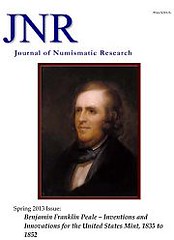 The Spring 2013 issue of the Journal of Numismatic Research might be of interest to your readers in relation to the transcription of
Franklin Peale's 1835 report.
The Spring 2013 issue of the Journal of Numismatic Research might be of interest to your readers in relation to the transcription of
Franklin Peale's 1835 report.
Having read the complete report during research of this JNR issue on Benjamin Franklin Peale – Inventions and Innovations for the United States Mint, 1835 to 1852, I feel that Peale's report is interesting but contains little to justify the time involved. I suggest that much greater numismatic value can be obtained from transcriptions of other US Mint and related documents.
For more informtion on the Spring 2013 JNR, see:
REVIEW: JOURNAL OF NUMISMATIC RESEARCH, SPRING 2013
(www.coinbooks.org/esylum_v16n52a06.html)
BOOK REVIEW: JOURNAL OF NUMISMATIC RESEARCH, SPRING 2013
(www.coinbooks.org/esylum_v16n14a07.html)
To read the earlier E-Sylum articles, see:
PEALE REPORT TRANSCRIPTION SOUGHT (www.coinbooks.org/esylum_v18n50a20.html)
CAN YOU READ FRANKLIN PEALE’S HANDWRITING?
(www.coinbooks.org/esylum_v19n09a11.html)
Fashionable Bibliophiles
Dave Ellison's Maundy Coins
Regarding my question about collecting Maundy coins, Dave Ellison writes:
While I do collect British coins, I have only one Maundy coin set. It is a 1969 four coin set that my father brought home for me from a trip to England in 1986. The coins are held in a blister pack and rest within a small presentation box. I also have an uncirculated 1837 Maundy silver penny that I really wish was part of a complete four coin set!
To read the earlier E-Sylum article, see:
THE 2016 ROYAL MAUNDY CEREMONY (www.coinbooks.org/esylum_v19n13a20.html)

ENGRAVED "HOBO STYLE" VICTORIA YOUNG HEAD PENNIES
David Powell writes:
Your article in the last E-sylum suggests that male heads are far more suitable for hobo engraving than female ones. In Britain, Queen Victoria Young Head bronze pennies of the 1860-94 issue were extensively subjected to this treatment, with a variety of interesting results, as per the attached depictions of the queen as (i) a military officer, (ii) a Salvation Army officer and (iii) a jockey.

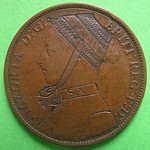
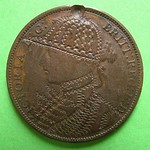
To read the earlier E-Sylum article, see:
ORIGIN OF HOBO NICKELS AND EARLY NICKEL CARVERS
(www.coinbooks.org/esylum_v19n13a22.html)

YOUNG NUMISMATISTS AND NUMISMATIC MULTIMEDIA
Bruce Perdue writes:
I read with interest the "HIDDEN BENEFIT OF A LARGE LIBRARY".
It sure worked for my two kids. Both graduated Summa Cum Laude and have advanced degrees. But the scary thing is that there are people who exist without books in their home. Less than 100? Heck, I am not sure that I have a room without at least hundred books.
Much of CoinWeek's original output now is in multi-media. Below are two good examples. The first is a podcast interview with Philip Diehl about the Royal Mint situation. Second is an installment of a three piece video about how coins are made at the Austrian Mint. This video focuses on the engraving process at the mint.
Last is a video of youngster Garrett Ziss's recent presentation for the Wilmington Coin Club on Capped Bust Images on Currency, which found its way to Kenny's numismatic YouTube channel. Len Augsburger and I had talked about the popularity of Kenny's channel and numismatic video in general. All of these things are great developments for our hobby, but something all publishers need to be taking seriously. -Editor
To listen to the podcast:
CoinWeek: U.S. Mint Director Philip Diehl Discusses Royal Mint
Lega... (http://coinweek.podomatic.com/entry/2016-03-29T13_13_37-07_00)
To watch the Austrian Mint video, see:
CoinWeek IQ: The Engraver’s Art: Coin Design and Die Preparation at the Austrian Mint
- 4K Video (https://www.youtube.com/watch?v=5OroYSprxXA)
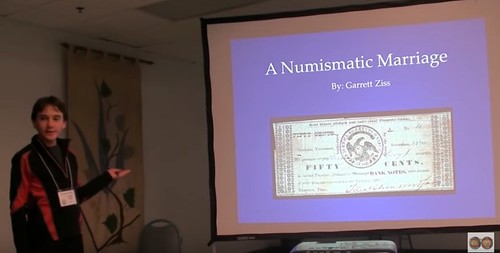
Garrett Ziss -A Numismatic Marriage-
To view Garrett Ziss' presentation, see:
Garrett Ziss-A Numismatic Marriage-Capped Bust Images on Currency-Wilmington Coin Club
Presentation (https://youtu.be/zRutpCEZ1wY)
To subscribe to Kenny's numismatic YouTube channel, see:
Numismatics with Kenny - Coin Collecting Videos
(www.youtube.com/channel/UCTqmf7rIfZpoACFI7-hY-8w)
http://numismaticswithkenny.com/
To read the earlier E-Sylum article, see:
HIDDEN BENEFIT OF A LARGE LIBRARY
(www.coinbooks.org/esylum_v19n13a34.html)
THE SAN FRANCISCO MINT ROBOTS
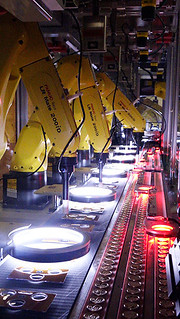 Housed on the first floor of the United States Mint at San Francisco, a line of yellow robots move with precision over a conveyer belt.
Behind the clear acrylic windows, each robot has a distinct mission assembling packaging and coins for various proof sets.
Housed on the first floor of the United States Mint at San Francisco, a line of yellow robots move with precision over a conveyer belt.
Behind the clear acrylic windows, each robot has a distinct mission assembling packaging and coins for various proof sets.
The robots are part of the facility's Farason line, which was installed in 2010. The robotics loop, one of the cutting edge technologies used by the Mint, improving the quality and the rate of production for the sets San Francisco makes. The old line could produce at a rate of approximately 600 sets per hour. The new robotics loop triples that output at a rate of approximately 1,800 per hour.
The Farason line has been busy in recent months making the last year of the Presidential $1 coin series. The Presidential $1 Coin Program, which started in 2007 and honored all deceased United States presidents, will come to an end in 2016 when the United States Mint at San Francisco mints the last coins.
Packaging the 2016 coins once they've been minted, along with other proof sets made at the facility, falls to a series of robots tucked away in a corner of the San Francisco facility.
“The robotic loop makes us a technology leader,” said Dave Jacobs, the plant manager. “The line helps package the coins for the largest producer of proof coins in the world, the United States Mint at San Francisco.”
Justin Hatch, a packaging machine operator leader in San Francisco, explained each of the robots and their purpose.
Robot 1 inspects the blister, or the pre-formed plastic insert. The robot picks up the blister and holds it against a tracking camera, which takes a picture and assigns a score to the item. If the score meets quality standards, the blister moves on. If there's a quality problem with the blister such as a scratch or crack, the item gets sent down a slide into a reject bin.
Robot 2 takes off bottom trays and places them onto the belt. When this robot places the trays, it attempts to place them parallel to the belt.
Robots 3 through 8 are called “pick and place robots.” Their job is to pick up coins and place them into the trays. If the item is a three coin set, only robots 3, 4 and 5 are working. The other three robots are used for sets that involve sets with four, five or six coins.
Before each pick and place robot does their job, there's a tracking camera that is inspecting the packaging and taking a measurement of the orientation of the packaging. Since the packaging could slightly move, the inspection cameras tell the robots to change the orientation of the coin.
To read the complete article, see:
Robotics Loop Keeps San Francisco at Forefront
of Technology (www.usmint.gov/pressroom/insidethemint/index.cfm?action=san-fran-robotics)
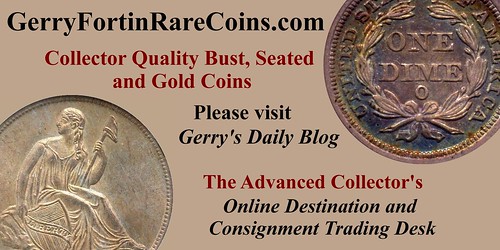
MORE ON THE 1974-D ALUMINUM CENT LAWSUIT SETTLEMENT
 After finding a one-of-a-kind aluminum penny potentially worth hundreds of thousands of dollars, the finder, Berkshire Hathaway Realtor
Randy Lawrence, and Michael McConnell, owner of La Jolla Coin Shop, teamed to verify and capitalize on the find.
After finding a one-of-a-kind aluminum penny potentially worth hundreds of thousands of dollars, the finder, Berkshire Hathaway Realtor
Randy Lawrence, and Michael McConnell, owner of La Jolla Coin Shop, teamed to verify and capitalize on the find.
But after a court battle with the federal government, which also claimed ownership of the 1974-D aluminum one-cent piece, the Realtor and the numismatist settled, ultimately, for donating it back to the United States Mint in Denver, of which Lawrence’s father Harry had been a deputy director until his retirement in 1979.
When McConnell discovered how rare Lawrence's penny was, Lawrence noted the coin dealer was “too honest” not to inform him about it, and the two agreed to work together to auction it off.
“But then the federal government stepped in and said they wanted the coin back,” Lawrence said, noting that that derailed their plans to auction the coin, with an estimated minimum value of $250,000, and donate up to $100,000 to fight homelessness locally.
To make a long story short, McConnell and Lawrence finally agreed to drop their lawsuit with the government over the rare coin and instead reached a settlement with the U.S. Mint that would preserve the coin’s historical significance for public appreciation and display.
“We didn't get any money, but we still feel really good about (donating) it,” said McConnell, adding, “We know it (coin) isn't a unicorn anymore. It does exist.”
Though he didn't profit materially from the rare coin, McConnell noted going through the legal system was a great learning process, which in and of itself had value. Lawrence described the finding of the rare coin and the ensuing legal battle as a “wonderful journey.”
Of the end result, Lawrence said, “It's a feel-good story — without the money. I know my father would be pleased that others will get to see and enjoy this rare piece in the U.S. Mint collection for years to come.”
To read the complete article, see:
This coin dealer knows where
the real treasure is (http://sdnews.com/view/full_story/27140237/article-This-coin-dealer-knows-where-the-real-treasure-is)
To read the earlier E-Sylum article, see:
U.S. MINT REGAINS DISPUTED 1974-D ALUMINUM CENT
(www.coinbooks.org/esylum_v19n12a18.html)
COLONIAL COUNTERFEITERS OF EVIL NAME AND FAME
Maureen Levine writes:
E-Sylum readers might enjoy these period court documents and contemporary counterfeits. I did the transcriptions and would welcome corrections from readers.
Colonial Counterfeiters of Evil Name and Fame and Dishonest Conversation
 Two intriguing court documents from North Carolina appear in Selections from the Eric P. Newman Collection Internet Part 1. In the first,
Henry Ebon Sears “uttered and passed” the two counterfeit 20 shillings notes that are affixed to the document. For this he was designated as “a
person of evil name and fame and dishonest conversation.” James Ward was convicted of “Passing bad Money,” in this case a Virginia 3 pounds note, to
one George Admire “ ...unjustly and Injuriously to Deceive and Defraud on the Seventeenth day of September in the third Year of the Reign of our
Sovereign Lord George the third by the Grace of God of Great Britain France and Ireland King Defender of the faith, and so forth...”
Two intriguing court documents from North Carolina appear in Selections from the Eric P. Newman Collection Internet Part 1. In the first,
Henry Ebon Sears “uttered and passed” the two counterfeit 20 shillings notes that are affixed to the document. For this he was designated as “a
person of evil name and fame and dishonest conversation.” James Ward was convicted of “Passing bad Money,” in this case a Virginia 3 pounds note, to
one George Admire “ ...unjustly and Injuriously to Deceive and Defraud on the Seventeenth day of September in the third Year of the Reign of our
Sovereign Lord George the third by the Grace of God of Great Britain France and Ireland King Defender of the faith, and so forth...”
The fate of the perpetrators is not known from the document text, which was sometimes undecipherable. Any information on probable punishments is welcome as are additions or corrections to the transcriptions.
This unique and fascinating primary source document has two different contemporary counterfeit North Carolina 20 shillings notes affixed to it on the docketed side. The legal text is fascinating. And the phrase referring to the "utter[er] and pass[er]" of the notes, Henry Ebon Sears as "a person of evil name and fame and dishonest conversation," reflects that there were bad guys in all periods of history.
The jurors for the State upon their oath present that Henry Ebon Sears, late of the county of Gates yeoman, being a person of evil name and fame and dishonest conversation, on the twenty fourth day of february in the year of our Lord one thousand seven hundred and eighty four and in the eighth year of American Independence, two bills of false money counterfeited to the likeness and similitude of the good legal and current money of the State of the denomination of twenty shilling bills emitted agreeable to an act of the general assembly passed at Hillsborough the eighteenth day of April in the year of our Lord one thousand seven hundred and eighty three then and there falsely, deceitfully and feloniously did utter and pass ______________ to one John Bryan, for and as the good and lawful currency of the said State of the denomination and imitation aforesaid ( he the said Henry then and there well knowing the said bills by him so uttered and passed – as aforesaid, to have been false and counterfeit against the act of the general assembly in that case made and provided and against the peace and dignity of the said State.
The complete lot description is available at:
http://currency.ha.com/itm/colonial-notes/north-carolina-may-17-1783-20-shillings-contemporary-counterfeit-type-pair-mounted-to-court-document-fr-nc-206a-and-nc-206b/a/241618-86204.s?ic4=GalleryView-Thumbnail-071515
Virginia October 12, 1758 3 Pounds Contemporary Counterfeit Pinned to Period Docketed Document Fr. VA-22. PCGS Extremely Fine 40 Apparent.
This is another fascinating and unique legal primary source document concerning Colonial counterfeiting. The Virginia 3 pounds note pinned upon the bottom left of the document's text side covers some of the text. As with the North Carolina notes and document above, the phrase "...being a Person of Evil Name, fame, and Dishonest Conversation..." appears. A rare counterfeit note, and made more desirable with this primary source documentation and period seizure.
Docket: The King vs } Induction [?] James Ward Passing bad Money Evidence George Admire Sworn and Sent John [?] True Bill Signd by Nathl [Alenworth?] Foreman R Henderson Att Thrd [?] Dom. Regis Document Side North Carolina Salisbury District [?] } At Superior Court of Justice held at Salisbury for the District of Salisbury on the Twenty Second day of September in the third Year of the Reign of Our Sovereign Lord George the third by the Grace of God of Great Britain France and Ireland King Defender of the faith, and so forth, According to the form of the Act of Assembly in Such Case made and Provided, before Maurice Moore Esquire Associate Judge of the said Court The Jurors for our Lord the King upon their Oath Present That James Ward late of the Parish of Saint of Luke in the County of Rowan Laborer, being a Person of Evil Name, fame, and Dishonest Conversation and Decifing [?] and Intending one George Admire, unjustly and Injuriously to Deceive and Defraud on the Seventeenth day of September in the third Year of the Reign of our Sovereign Lord George the third by the Grace of God of Great Britain France and Ireland King Defender of the faith, and so forth, at the Parish Aforesaid in the County Aforesaid one piece of Printed Passed [?] Counterfeited to the Likings and Similitude of a Bill of the Current money of the Colony and Dominion of Virginia of the Denomination of Three Pounds, forwit of the Notes of Forty Eight Shilllings Lawful money of Great Britain, Unlawfully Fraudulently and Deceitfully did utter and Pass to the said George Admire for and as a good and Trued Bill of the Denomination and Value of Three Pounds Current money of the Colony of Virginia Aforesaid, forwit, of the Value of Forty Eight Shillings Lawful money of Great Britain as Aforesaid, He the said James Ward then and there and there -----------------------------------------------Bill so as Aforesaid by him so Uttered -------------------------------------------------------------Counterfeit to the Great Damage -------------------------------------------------------------[Ge]orge Admire and Against the Peace of -------------------------------------------------------------Crown and Dignitye --------------------------- ----------------------------------Rich'd Henderson Att Thrd [?] Dom. Regis
To read the complete lot description, see:
http://currency.ha.com/itm/colonial-notes/virginia-october-12-1758-3-pounds-contemporary-counterfeit-pinned-to-period-docketed-document-fr-va-22-pcgs-extremely-fine/a/241618-86300.s?ic4=GalleryView-Thumbnail-071515
To bid, or access the downloadable catalog of Selections from The Eric P. Newman Collection Internet Part I, see:
http://www.ha.com/241618

Archives International Auctions, Part XXXII
U.S., Chinese, Russian & Worldwide Banknotes,
Scripophily and Coins
April 11-13, 2016
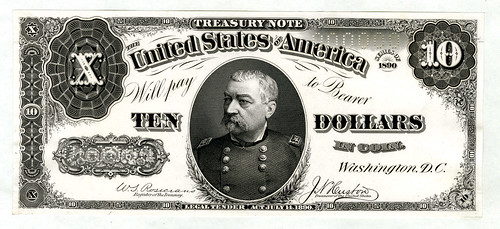
Click the links! Highlights include:
Lot 62: French Guiana. 5 New Francs 1961 Provincial Issue
Lot 85: Guadeloupe, 1 Noveau Franc on 100 Francs
Lot 104: Reserve Bank of India "Persian Gulf Note"
Lot 111: Government of Iraq 10 Dinars of King Faisal II
Lot 201: Philippine Islands Silver Certificate Unique Presentation Proof
Lot 255: Francis Spinner Letter, 1871.
Lot 479: Copper Printing Plate Engraved By William Kneass, Chief Engraver
Lot 499: U.S. Legal Tender Treasury Note, Unique Presentation Proof, $10, Series of 1890
Lot 1056: Lao 1948 Unlisted Color Trial Specimen Essay Banknote
Lot 1351: Vladikavkaz Railroad Company 1919 Interest Bearing Loan Note Rarity
Lot 2053: Bank of China, 1918 "Tsining / Shangtung" Issue Rarity
Lot 2258: Deutsch-Asiatische Bank, 1907 "Peking" Branch Rarity
Lot 2319: Peiyang Tientsin Bank, ND (1910) Tael Issue
Lot 2263: Netherlands Trading Society, 1909 Issued Banknote
View the Virtual Catalog
Download the Catalog in PDF format
ARCHIVES INTERNATIONAL AUCTIONS, LLC
1580 Lemoine Avenue, Suite #7
Fort Lee, NJ 07024
Phone: 201-944-4800
Email: info@archivesinternational.com
WWW.ARCHIVESINTERNATIONAL.COM
JEWISH-AMERICAN HALL OF FAME GERTRUDE BERG MEDAL
 The Jewish-American Hall of Fame inductee for 2015, radio and television pioneer Gertrude Berg (better known as Molly Goldberg), appears on
limited edition, high relief art medals sculpted by Eugene Daub, that Mel Wacks, Director of the JAHF says “are guaranteed to make you smile.”
The Jewish-American Hall of Fame inductee for 2015, radio and television pioneer Gertrude Berg (better known as Molly Goldberg), appears on
limited edition, high relief art medals sculpted by Eugene Daub, that Mel Wacks, Director of the JAHF says “are guaranteed to make you smile.”
The obverse depicts writer and performer Gertrude Berg as Molly Goldberg, leaning out of her Bronx apartment window shouting “Yoo-Hoo Mrs. Bloom” (as she opened her television show); the reverse features members of the original cast of her groundbreaking sitcom “The Goldbergs.”
The 47th issue in the longest continuing series of art medals being produced in America is available in bronze (115 made), 3 oz. pure silver (56 made), and gold-plated 3 oz. pure silver (27 made), priced at $45, $200, and $250 respectively. Each 2-inch art medal is individually serial numbered and comes with a certificate of authenticity. They can be ordered by calling the non-profit Jewish-American Hall of Fame at 818-225-1348. Mention that you read about it in The E-Sylum, and take a 20% discount.
Gertrude Berg was born Tillie Edelstein in New York City in 1898. Her father, Jake Edelstein, ran a resort in the Catskill Mountains where Tillie worked and eventually created and performed skits to amuse the guests' children. She met an older Englishman, Lewis Berg, one summer at the resort, and when she turned eighteen they married. A few years later, she started to pursue her writing and acting careers full time, changing her name to Gertrude Berg.
Berg began writing radio scripts based on a fictional family she had formulated as a young woman, now calling them “The Goldbergs,” a combination of her mother's maiden name and her husband's last name. “The Goldbergs” premiered on radio in 1929 with Gertrude filling in for the role of Molly until another actress could be found. She was so good that when she was sick for a week the public sent in mass amounts of fan mail asking, "Where's Molly?" Audiences loved listening to the stories and struggles of the Goldberg family and their neighbors, and instantly took to the warmth and guidance of the accented Molly Goldberg.
In 1947, following her 17 year run on radio, Gertrude saw television as a new exciting media, and a new opportunity to reinvigorate and reintroduce “The Goldbergs” following World War II. “The Goldbergs” premiered on CBS in 1949, with Gertrude Berg as lead writer, star, and producer yet again.
In 1950, Gertrude Berg won the first best actress Emmy Award in history, she had a clothing line for housewives, published a cookbook, and wrote an advice column called “Mama Talks.” The Goldbergs eventually moved from the Bronx to the suburbs, and continued until 1954, after which Berg also wrote and produced a syndicated film version that remained on the air for another few years.
Gertrude Berg’s pioneering show “The Goldbergs” blazed the trail for “I Love Lucy” and all other sitcoms to follow!
Picture is attached, courtesy of Jewish-American Hall of Fame. Suggested caption is: The 2015 Jewish-American Hall of Fame medal, designed by award-winning sculptor Eugene Daub, features radio/television writer and performer Gertrude Berg as Molly Goldberg—shouting “Yoo-Hoo Mrs. Bloom”-- and the original cast of her groundbreaking sitcom “The Goldbergs.”
For more information on the Jewish-American Hall of Fame, see:
http://www.amuseum.org/
LIBERTY PORTRAIT RECOMMENDATION DRAWS CRITICISM
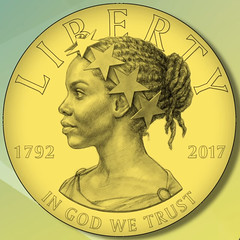 The recent decision by members of both the Citizens Coinage Advisory Committee and the Commission of Fine Arts to recommend a portrait of
an African American woman as the Liberty figure for the 2017 American Liberty silver medal and gold coin has been polarizing, to put it mildly. A lot
of collectors are not at all supportive; many of them loathe the idea — and they have not been shy in their comments at Coin World’s Facebook page
and in their email to me.
The recent decision by members of both the Citizens Coinage Advisory Committee and the Commission of Fine Arts to recommend a portrait of
an African American woman as the Liberty figure for the 2017 American Liberty silver medal and gold coin has been polarizing, to put it mildly. A lot
of collectors are not at all supportive; many of them loathe the idea — and they have not been shy in their comments at Coin World’s Facebook page
and in their email to me.
Supporters of the decision and the design have been a distinct minority; I estimate that some 80 percent or so of those commenting fall into the “anti” camp, with about 20 percent welcoming the recommendation (and I count myself among the latter; a wrongheaded decision, some readers have told me).
For those who like the idea, introducing new concepts of Liberty not necessarily rooted in ancient Greek art is a wonderful way of recognizing the immense diversity of our nation. As one writes, “It’s about time our money reflects the beauty of America’s racial diversity.”
The opposition to the design seems to fall into three or four or more categories, with some crossover. Some just don’t like the design on aesthetic grounds. Others are rejecting the design without explicitly saying why. Then there are those who call the idea of an African American Liberty “politically correct garbage,” or another example of an America changing into something they don’t support. Others see the abandoning of the classical Liberty, with its roots in Europe, as tossing tradition out the window. Still others point fingers at President Obama or the U.S. Mint as being responsible, though that is not accurate, as one person intimately involved in the decision explains.
Heidi Wastweet is a talented sculptor and medalist, and a member of the CCAC. In the March 27 issue of The E-Sylum, the weekly electronic newsletter of the Numismatic Bibliomania Society, she discusses the origins of the American Liberty gold coin and silver medal program, which made its debut in 2015.
Lest you think that the CCAC is some stereotypical “Washington elites” organization out of touch with the coin collecting community, be aware that the membership is dominated by the numismatic community. Of the 11 current members, 10 are coin collectors, numismatists, or medal/coin designers. “They” are “us.” Some on the panel have been coin collectors for decades; many are award-winning writers, researchers, and artists. Not all of the current members served on the panel when the American Liberty program was first proposed, but the current domination of the CCAC by the collecting community has always been present.
So why are so many collectors so strongly opposed to the design decision? Why are so many of them so angry about the proposal?
Some of the anger seems very similar to the anger being expressed in the current presidential campaign, as voiced by both candidates and followers. One only has to follow the daily news to know that the current campaigns have had their ugly moments. Some of those angry about the CCAC/CFA decision seem to be tapping into that same well of anger, aimed at a changing America, an abandonment of tradition, and a climate of what they perceive as political correctness run amuck.
Getting back to those opposing the design, there is one more category — one with racist undertones — that I and others have found to be especially disheartening. Overtly racist comments have been in a minority, thankfully, but some of those favoring the design have called out what they see as racism in other postings. And this leads to my next observation.
America is changing. We’re becoming much more diverse on many levels, and while some in the nation are upset with those changes, census studies suggest that those changes are not going to stop. But is the coin collecting community keeping pace with greater America?
To read the earlier E-Sylum article, see:
THE HIGH RELIEF LIBERTY SERIES (www.coinbooks.org/esylum_v19n13a14.html)
To read the complete article, see:
AFRICAN AMERICAN LIBERTY PORTRAIT RECOMMENDATION
DRAWS CRITICISM (www.coinworld.com/voices/bill-gibbs/2016/04/african_americanlib.html)

LIBERTY DOLLAR CREATOR VON NOTHAUS ISSUES "TRUMP DOLLARS"
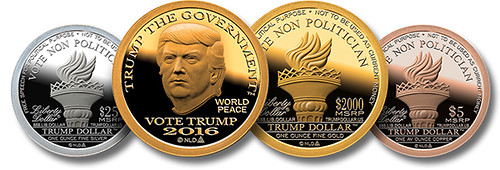
Donald Trump supporters can show their enthusiasm for the 2016 Republican presidential hopeful by purchasing Trump Dollar coins.
“Fed up with the political class?” ask the promoters. “Fed up with money that loses value?”
The pointed language matches the perturbed tone of the presidential candidate the coins honor; the copper, silver, and gold rounds invite coin collectors, metals investors, and Trump backers to express their disfavor of fiat money and political dogma by purchasing these bullion-based collector pieces, which are available in uncirculated and proof formats.
The Trump Dollar coins are issued by the Congressional Mint, a private minting firm located in Hudson, Wisconsin. They are among a multitude of Trump-emblazoned products hitting the market these days, including Donald Trump wine, Donald Trump steak and Donald Trump water. It seems Donald Trump approves of these capitalistic political messages; unveiling of the new Trump Dollar coins will be held at a First Day of Issue event at the Trump Tower in New York City on April 27.
While the coins are not legal tender (nor are they advertised as such), they hearken to the financial ideology of many Trump supporters who would prefer to see the U.S. monetary system return to the silver and gold standards, which the United States was on throughout much of the nation’s history.
Each coin contains one ounce of bullion metal.
The one-ounce copper $5 piece sells for $5 in uncirculated condition while the one-ounce Trump $25 silver coin is offered at $25. Proof examples of the copper and silver rounds are listed for $14.95 and $39.95, respectively, on the Congressional Mint’s website. Meanwhile, the $2,000 gold coin is available as a proof round in a three-piece proof set that also includes proof examples of the copper and silver rounds. The three-coin set sells for $2,450. Five percent of the net sales will be donated as proceeds to the Special Operations Warrior Foundation, which provides charitable assistance to wounded and hospitalized special operations military personnel.
The copper, silver, and gold coins share common obverses and reverses. The obverse is anchored by a bust of Trump looking just to the left of the viewer. TRUMP THE GOVERNMENT is inscribed along the top two-thirds of the obverse rim, followed by a trademark symbol. Below and to the right of “the Donald” are the words WORLD PEACE inscribed in two lines. In bold font, the phrase VOTE TRUMP is stamped directly below Trump’s bust. The date of the coin, borne in large font, is centered below and near the bottom obverse rim, just above small-print copyright mint symbols.
The reverse features a burning torch reminiscent of that held by the Statue of Liberty in New York City. The torch is surrounded with numerous phrases and slogans. These include FREE SPEECH FOR POLITICAL PURPOSE * NOT TO BE USED AS CURRENT MONEY, as found in small print along the top two-thirds of the rim. Below those words is the motto VOTE NON POLITICIAN. The respective face value of the coin is found to the bottom right of the torch; below the denomination, the TRUMPDOLLAR.US website address is listed. Toward the bottom left of the torch are the inscriptions LIBERTY DOLLAR and .888 LIB. DOLLAR. TRUMP DOLLAR is centered horizontally below the torch, and below that phrase, the one-ounce weight of the coin and its metal content is listed in small text. Copyright and mint insignias are featured in tiny print at the bottom center of the coin near the rim.
The Trump Dollars were designed by Bernard von NotHaus, who also designed the notorious, privately-minted Liberty Dollar several years ago. Heavily promoting his Liberty Dollars in magazines, online, and on television in the early 2000s, von NotHaus encouraged people to exchange their Federal Reserve notes for his private-issue bullion money. Von NotHaus drummed up interest in his gold and silver coins claiming the Federal Reserve was “unconstitutional and harmful.”
In 2009, the U.S. government charged von NotHaus with federal crimes and found him guilty in 2011 of “making, possessing, and selling his own currency.” In 2014, the 71-year-old von NotHaus was sentenced to three years probation.
To read the complete article, see:
Private Mint Trump
Dollars One-Up Legal Tender Coinage
(www.coinweek.com/coins/branded-products/will-private-mint-trump-dollars-one-legal-tender-coinage/)
To read the earlier E-Sylum articles, see:
SO ... WHATEVER HAPPENED TO BERNARD VON NOTHAUS?
(www.coinbooks.org/esylum_v13n43a21.html)
UPDATE ON LIBERTY DOLLAR PROMOTER BERNARD VON NOTHAUS
(www.coinbooks.org/esylum_v14n15a15.html)
LIBERTY DOLLAR CREATOR BERNARD VON NOTHAUS SENTENCED
(www.coinbooks.org/esylum_v17n50a16.html)
THE BOOK BAZARRE
WAYNE'S NUMISMATIC DIARY: MARCH 31, 2016: PART 1
Visiting the Dave Hirt Numismatic Library
Thursday March 31, 2016 was an all-day numismatic affair for me. I'd taken a day off work to handle some business for the Newman
Numismatic Portal. With a little time to kill in the morning I had breakfast at a Panera Bread restaurant, using my laptop to wrap up
E-Sylum advertising invoices and start setting up this week's issue.
My first stop was a visit to an old friend. I took the back roads out of Virginia and across the ricketey-looking Point-of-Rocks bridge across the Potomac into Maryland, where my GPS system navigated me to the Frederick, MD home of Emi and Dave Hirt.
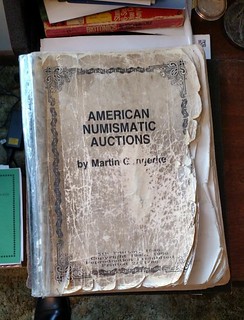 Dave is a longtime Numismatic Bibliomania Society member, former NBS Treasurer, and big-time collector of numismatic literature. He's
my hero because he not only collects the material, he seems to read and remember it all, making him a fount of knowledge of the ins-and-outs of 19th
century American numismatics. His copy of Gengerke's American Numisamtic Literature is the most shopworn I've ever seen (although Len
assured us that Dan Hamelberg's copy is just as bad).
Dave is a longtime Numismatic Bibliomania Society member, former NBS Treasurer, and big-time collector of numismatic literature. He's
my hero because he not only collects the material, he seems to read and remember it all, making him a fount of knowledge of the ins-and-outs of 19th
century American numismatics. His copy of Gengerke's American Numisamtic Literature is the most shopworn I've ever seen (although Len
assured us that Dan Hamelberg's copy is just as bad).
I pulled into their drive about 11am. Also arriving in his rented car was NNP Project Coordinator Len Augsburger. He'd been in town
to scope out U.S. Mint material at the National Archives. We were visiting to have a look through Dave's library for unique, unusual or
interesting items to digitize for the benefit of numismatic researchers.
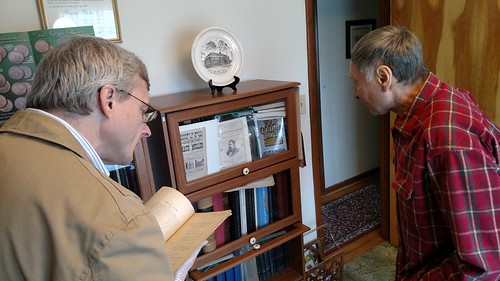
Len Augsburger and Dave Hirt
We started in a first-floor office with a couple bookcases of material and some framed numismatic photos on the wall. Below is a picture I took of a labeled photo of a "Banquet given by Thomad L. Elder to buyers at an early auction sale of his". The assemblage is a Who's Who of American numismatic personalities including Elder, Farran Zerbe, Stephen Nagy, Howland Wood, and Edgar Adams.
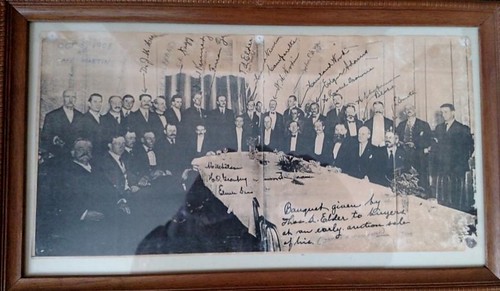
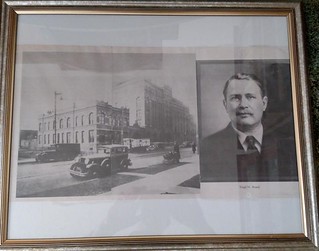
Virgil Brand photo

In addition to a set of Proceedings of the Numismatic and Antiquarian Society of Philadelphia and some important catalogs not among the bound sets being scanned at the ANS, we picked out some interesting addenda, house organs and pamphlets.
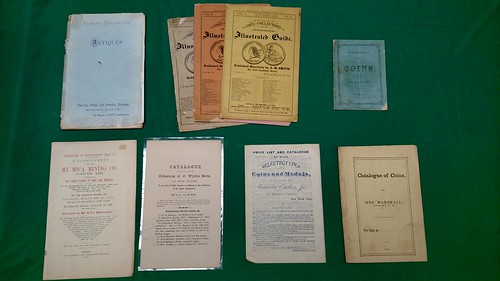
After Len made an inventory of the items being borrowed for the Newman Numismatic Portal I boxed them up and took them to my car. By now it was 1pm and time for a late lunch. We sat down at the dining room table and Emi served up fresh toasted bread, homemade chicken salad and cooked peppers from their garden.
The Gibbs Files
After lunch I opened a box of material I wanted to show Len and Dave - correspondence files of Pittsburgh collector Howard Gibbs. I'd
aquired the material some twenty years ago from the estate of Western Pennsylvania Numismatic Society member Emerson Smith.
It was on another day taken off work that I'd discovered the trove and rescued it from the dump. I was literally one room ahead of workers who were cleaning out Emerson's home and hauling everything to a dumpster. His family had already been through the place and taken or sold anything they deemed of value; the executor told me to help myself to anything I wanted. I'd contacted him because at the time I was working on a history of WPNS and was looking for old letters or archival material.
Emerson had never married, and was ill in his final years. The home was a mess. I took decades worth of old copies of the Numismatic Scrapbook and The Numismatist. Under a workbench in the garage I found three complete years of Mehl's Numismatic Monthly. And in an upstairs office I found a filing cabinet that yielded correspondence and other material relating to Emerson's friends Howard Gibbs and dealer Hans Schulman.
I'd had fun reading through the material, but it had been boxed in my own garage ever since, following me from Pittsburgh to Virginia, still a jumbled mess. The Newman Numismatic Portal gave me a reason to get it organized and a place to make the material available to other collectors and researchers.
Soon it was time to go. We packed my car, said our goodbyes, and headed out Rt. 70 East toward Baltimore. More in Part 2 of this Diary.

WAYNE'S NUMISMATIC DIARY: MARCH 31, 2016: PART 2
Baltimore Coin Show
After parking my car I made my way to the lobby of the convention center to register for the show. This was going to be a whirlwind. My
first stop was the table of Julian Leidman, which is right by the entrance to the show. We talked about The E-Sylum a bit, then made
plans to meet up again at dinner.
Among my next stops was the table of Anthony Terranova, seated in front was none other than former Congressman and collector extraordinare Jimmy Hayes. We chatted about rarity and the importance of immediately buying those once-in-a-lifetime items since, well, you may never get another chance. I also got to meet Tony Terranova, who was manning the table with his father.
I think I visited Doug Winter next, where I asked him this question - Would more or less U.S. gold coins have survived without Roosevelt's ban on holding gold? What do E-Sylum readers think?
I sat with Don Kagin at his table for a while discussing ideas for expanding the content on the American Numismatic Association web site. Afterwards I ran into Mark Ferguson, who introduced me to Mark Tabb, who is now a new E-Sylum subscriber.
I walked over to Dave Perkins' table, but he was with customers and I didn't want to butt in. I think I went next to visit bookseller Charlie Davis and his tablemate Neil Musante. While there Neil introduced me to E-Sylum subscriber Marc from Virginia.
Next stop was David Lisot's CoinTelevision table, where I ended up being interviewed on camera about my multiple projects, The E-Sylum, the Newman Numismatic Portal and NBS. I stammered my way through and felt lousy about my performance, but I know David is a master video editor and somehow it will come out all right.
In the aisle in front of Whitman's large booth I ran into Dave Wnuck and talked for a while. I showed him the new email count on my phone, and it was up to about 104. I would have a lot to plow through this weekend to complete The E-Sylum Guess I made it somehow.
My phone rang and it was Len Augsburger. We'd seperated after getting to Baltimore. Turns out he was calling from the next aisle over, so we hung up and I walked over to finish our conversation. We compared notes on Dave Hirt's shipment and called him to confirm.
It's hard for me to walk anywhere at a major show without running into people I know. Soon I was talking with David Sundman as he pored over obsolete banknotes at the table of dealer Tom Denly.
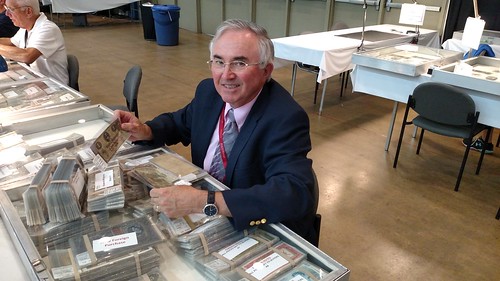
I left the show floor at nearly 6pm but I wasn't done running into people. I stopped to speak with Charles Morgan and Hubert Walker of CoinWeek where I learned Charles would be covering the upcoming Mint Director's conference. Lucky him!
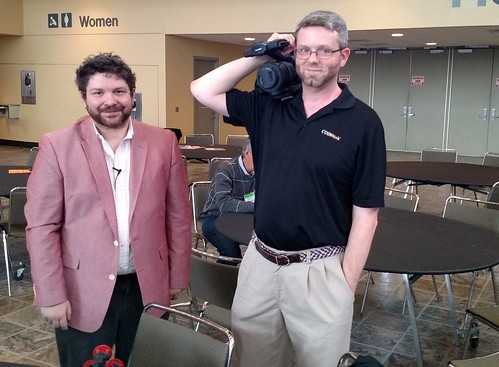
Charles Morgan and Hubert Walker
Next I headed toward the Sheraton Hotel lobby - destination: Morton's. More in Part 3 of this Diary.
THE BOOK BAZARRE
WAYNE'S NUMISMATIC DIARY: MARCH 31, 2016: PART 3
Nummis Nova 2016 Baltimore Dinner
As readers of The E-Sylum know, a highlight of my month is the regular dinner meeting of my Northern Virginia numismatic social
club, Nummis Nova. My out of town friends (and that means YOU, The E-Sylum readers) often tell me they'd love to join us
sometime if they're in town, and over the years a couple of you have been able to do just that.
A couple months back Dave Bowers invited us to come up to Wolfeboro for a visit, and several of us began thinking through options for a road trip sometime. But in the meantime, I suggested a less taxing option - a dinner at the Whitman Baltimore coin show with Dave and some of our other out-of-town friends. After an exchange of emails, plans were made.
And so it was that upon leaving the coin show floor, I put on a tie and headed over to Morton's for a special dinner of Nummis Nova members and our guests. Eric Schena was our host for the evening, and he'd arranged for a private room and made up namecards to help everyone put names to the new faces.
Regular Nummis Nova members besides myself and Eric were Tom Kays, Joe Esposito, Mike Packard, Julian Leidman, Dave Schenkman, Ron Abler and Roger Burdette. Out-of-towners included Maryland dealer Michael Merrill and collector Dr. Ben Swanson (guests of Dave Schenkman), Syd Martin (guest of Mike Packard), and Will Nipper (guest of Joe Esposito). My guests included Dave Bowers, David Sundman of Littleton Coin Co., Mary Burleson of Whitman Publishing, Len Augsburger of the Newman Numismatic Portal project, and Pat McBride and Tom Uram of the Pennsylvania Association of Numismatists.
Here are a few photos from the cocktail portion before taking our places at the table.
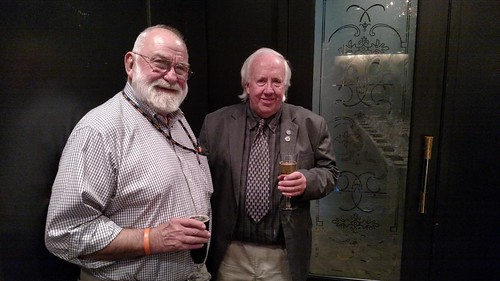
Ron Abler and Pat McBride
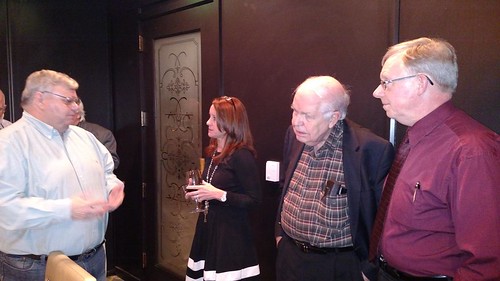
Roger Burdette, Mary Burleson, Dave Bowers, Wayne Homren
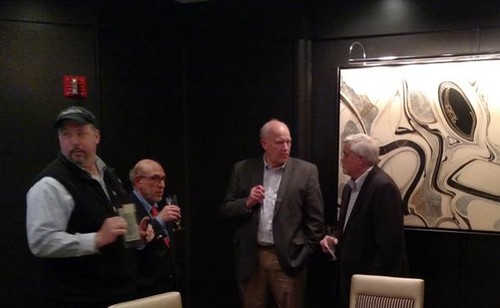
Tom Kays, Joe Esposito, Mike Packard, Will Nipper
Tom Kays writes:
“See the “Worlds of Wayne” as they collide with PAN / Nummis Nova / Whitman Empire / ANS / NNP / Stacks-Bowers / Littleton representatives and guests, all seated at table, like when at a wedding folks from different spheres of our lives come together from work, neighborhood, family and friends who settle in for cake with a similar group from the bride/groom’s side. The result is a potent mix of conviviality as we shared Thursday night. It was cool.
I understand Q. David Bowers talked with Eric Schena about travelling in Eastern Europe, glad of the freedom from formal duties that weigh down other gatherings he presides over. Our end of the table talked about recent coin finds at Jamestown, pouring one’s own silver bars, politics and Pistareens, the veracity with which we may name the models of Liberty depicted on the Morgan/Peace dollars and leaky aquariums.
Just as the Nuclear Summit in DC sent motorcades with twenty heads of state in new and interesting directions the very same night, perhaps we might call this Baltimore dinner a “Numismatic Summit” to send dealers, researchers, publishers, archivists, collectors and authors down new paths.
I guess it was a summit of sorts, although one with no particular agenda. I opened the dinner with some short remarks about how I had created Nummis Nova, basing it on The Sphinx Society, founded in Pittsburgh in 1960 by Ray Byrne. There are no Constitution and Bylaws, no reading of the minutes, no committees, no nothin' except the fun part - numismatic fellowship.
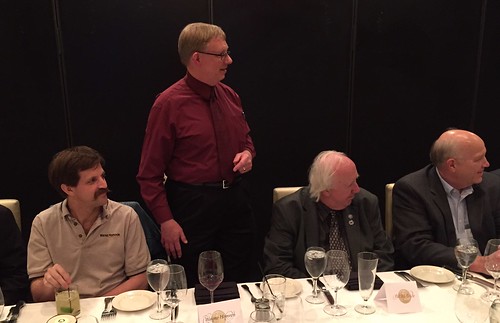
Wayne Herndon, Wayne Homren, Pat McBride, Mike Packard
Photo by Tom Kays
I introduced my guests and other members introduced themselves and their guests. Wayne Herndon joked about how often people across the hobby confuse the two of us, being two Wayne H's from Virginia. He said he'd "gotten some good book deals that way", and I responded that I'd gotten some good coin deals that way, too. (Not really, but I do get confusing emails and phone calls on occasion until I realize they want Mr. Herndon, the mustachioed one).
And then we got down to the fellowship part. The room was alive with conversation the rest of the night. I was sitting at the middle of our long table, between Pat McBride and Wayne Herndon, and across from Tom Uram, Dave Schenkman and Ben Swanson.
I learned that Ben lives just down the street from the Baltimore convention center. Poor Dave had just had dental surgery a few days before and had to be content with crab cakes rather than Morton's steaks. I indulged with an 8oz fillet. The evening already seems a blur, but I recall conversation topics included the upcoming PAN show, the Burns Memorial Library, Wayne's growing Wizard Coin Supply business, and new content for the Newman Portal.
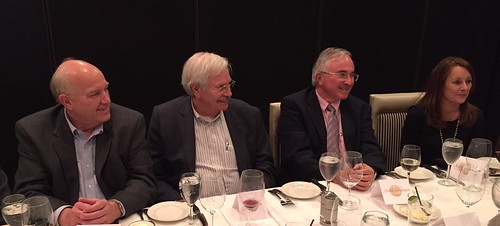
Mike Packard, Syd Martin, David Sundman, Mary Burleson
Photo by Tom Kays

Schena, Augsburger, Liedman, Uram, Schenkman, Swanson
Photo by Tom Kays
Joe Esposito adds:
Not surprisingly, the wide range of interests allowed for many stimulating discussions. Among them at our end of the table was one on American sculptors and medalists, including Augustus Saint-Gaudens, Anthony de Francisci, James Earle and Laura Gardin Fraser, and Paul Manship. Roger, who has written a trilogy of important books (“Renaissance of American Coinage”) which cover these artists and others, provided instructive insights.
Tom Kays adds:
To capture a remembrance from all the fleeting host of numismatic luminaries, I bothered everyone to deface a duce by signing my “short snorter.” Some had never done so, while others recalled similar actions in Viet Nam. Dave Bowers said we should tape more notes to this one as others are invited to sign, perhaps next year. Have you E-Sylum readers ever signed a “short snorter?” Tell us more.”
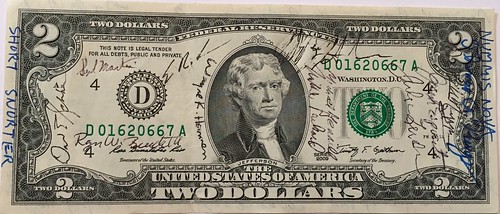
Photo by Tom Kays
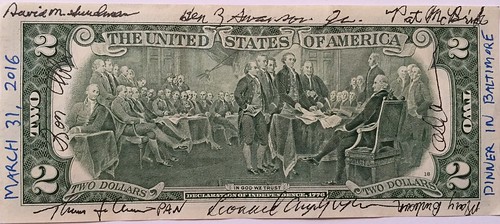
Photo by Tom Kays
As with the regular Nummis Nova dinners, it was a wonderful, relaxing night of numismatic discussion and fellowship. Here's a group shot taken by Tom as we were doing introductions.
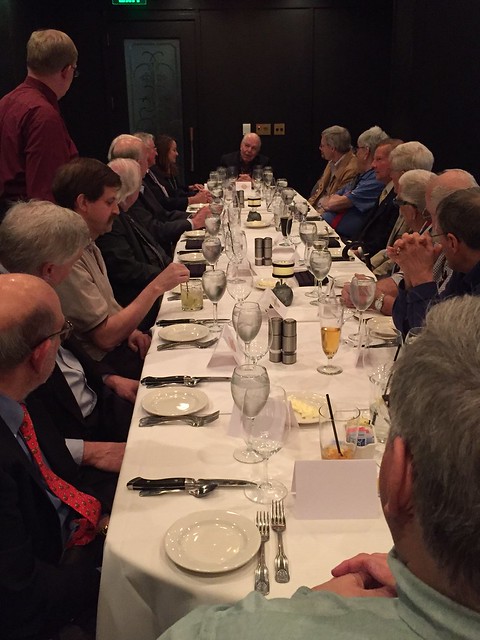
Before parting Dave Bowers suggested making this a regular event at the March Whitman Baltimore show, and we're already working to reserve the room in 2017.
I was dead tired after the long day and still had an hour's drive home. But the dinner was a marvelous cap to a great day of numismatics. It was wonderful to see everyone and have some relaxed conversations. I couldn't help but be mentally transported back to that Tom Elder dinner photo I'd seen that afternoon at Dave Hirt's. What a day to remember!
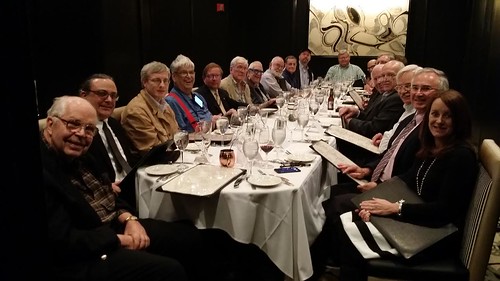
Photo by Morton's server, courtesy Eric Schena
ROYAL MINT REDEFINES LEGAL TENDER FOR COMMEMORATIVE COINS
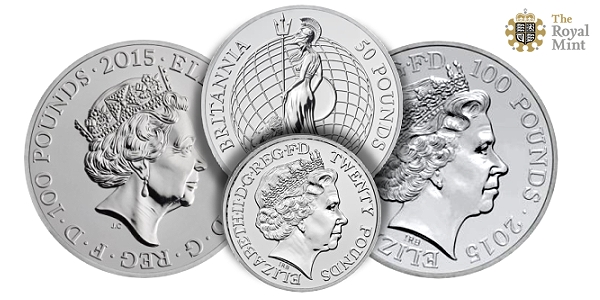
The Royal Mint of the United Kingdom, one of the world’s leading mints and manufacturers of circulating and commemorative coins, has established a disturbing precedent by actively advising UK banks not to redeem collector coins at face value–despite the fact that the Royal Mint states in its online product descriptions that collector coins are legal tender in the UK.
It’s a move that troubles industry insiders and the British public, many of whom were unaware that the commemorative coins they’ve bought over the years have no practical monetary value.
The issue came to prominence at the end of 2015, when the Mint learned of a scheme wherein buyers would order bulk quantities of the Buckingham Palace £100 commemorative coin only to later redeem them at face value.
According to article published in January 9 by the UK financial website thisismoney.uk, one man purchased 293 of the coins in order to accrue airline miles on his credit card.
It wasn’t his first time, either. The man, identified only as “James”, said he would “purchase the face value of coins of £20, £50 and £100 and max out [his] credit card.” Then he would take the coins to a branch of HSBC Bank and redeem them.
This seemed to work, until it didn’t.
For while James was making deposits, the bank was seeking guidance from the Royal Mint on what to do with these precious metal commemorative coins – coins that, while advertised as “legal tender”, were not intended for circulation.
Fortunately for James (but maybe not so much for his preferred bank branch), he unloaded 210 of the coins before being told that the remaining 80 would not be accepted.
At the time of this writing, 80 £100 pound commemorative coins, if convertible to circulating money, would have a value of US$11,303, with an intrinsic value of approximately $2,441.60.
... the Royal Mint provides the following guidelines for the maximum legal tender of each of the coin denominations that it strikes:
- £100 – for any amount
- £50 – for any amount
- £20 – for any amount
- £5 (Crown) – for any amount
- £2 – for any amount
- £1 – for any amount
- 50p – for any amount not exceeding £10
- 25p (Crown) – for any amount not exceeding £10
- 20p – for any amount not exceeding £10
- 10p – for any amount not exceeding £5
- 5p – for any amount not exceeding £5
- 2p – for any amount not exceeding 20p
- 1p – for any amount not exceeding 20p
It is interesting to note that the coin denominations of £20, £50 and £100 are all special commemorative issues, and not struck for general circulation. Yet, according to the Royal Mint, coins in these denominations have unlimited legal tender status.
To read the complete article, see:
How The Royal Mint is Attempting to Redefine
“Legal Tender” for Collector Coins (www.coinweek.com/opinion/royal-mint-redefines-legal-tender-coin-collectors/)
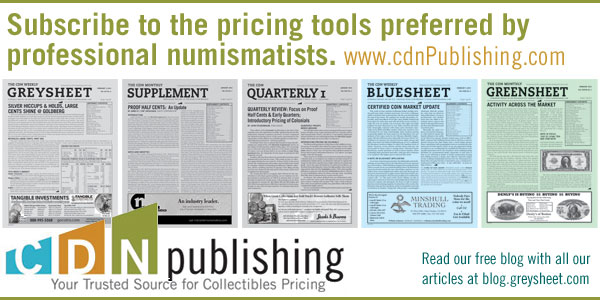
WOMEN AND LABOR ON PAPER CURRENCY
"How often, when man abandons the helm in despair, woman seizes it, and carries the home-ship through the storm! Man often flies from home and family to avoid impending poverty or ruin. Woman seldom, if ever, forsook home thus."
–Woman in Adversity from Godey's Lady's Book, 1861
The quote above from Godey's Lady's Book, a popular 19th-century women's magazine, offers a familiar depiction of women as homemakers and mothers sailing the "home-ship." Yet, a banknote issued that same year by the Sanford Bank of Sanford, Maine, depicts two women weaving at industrial looms; a third unattended loom behind them indicates that this is a factory scene, and that these women did in fact leave home to avoid poverty through paid work.
Paper currency is not only a symbol of monetary value, it is a form of print media, and consumers look at the images on their paper money every day. Therefore the men who designed the Sanford Bank note made deliberate choices when they selected this image. This isn't the only example of women depicted as laborers on notes. In contrast to the current American norm of featuring famous people on notes, anonymous women at work have been a popular subject for money starting in the 19th century, and they appear in places as far apart as the United States and French Equatorial Africa.
In order to understand why everyday women appear on so many types of notes in so many places and times, it is important to understand the role that images on money fulfill. On banknotes issued by governments, detailed images can help to make counterfeiting more difficult, but they also provide an opportunity to depict national values in a place that citizens will see every day.
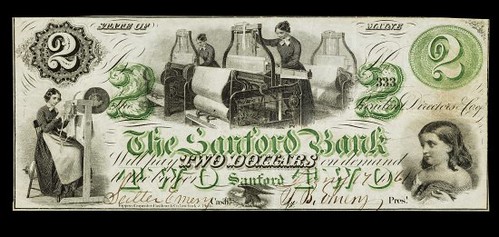
In 2015 when the U.S. Secretary of the Treasury announced the redesign of the ten dollar bill to feature a woman, the press release expressly stated that the woman chosen would emphasize something about American democracy. The Israeli half do[pound] note from 1958 is another particularly striking example of notes expressing national values. The image is of a muscular woman wearing a dress, and holding a large basket full of apples. Her hair is windblown and she is standing against a background of manicured fields, where she presumably harvested her fruit. This image sends a clear message: the ideal Israeli female citizen is feminine and strong, and actively participates in the economy.
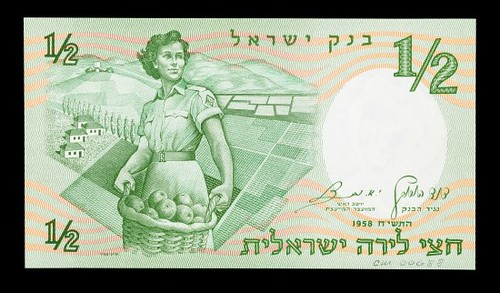
1958 Israel Half Pound note
To read the complete article, see:
Women's work: Depictions
of idealized women and labor on paper currency
(http://americanhistory.si.edu/blog/womens-work-depictions-idealized-women-and-labor-paper-currency)
SCOTTISH BANKNOTES OFFERED BY PAM WEST
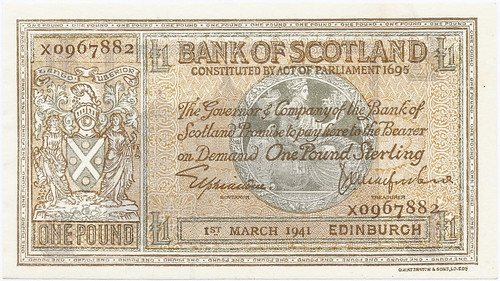
Bank of Scotland 1941 One Pound Note

1969 Bank of Scotland Twenty Pound Note
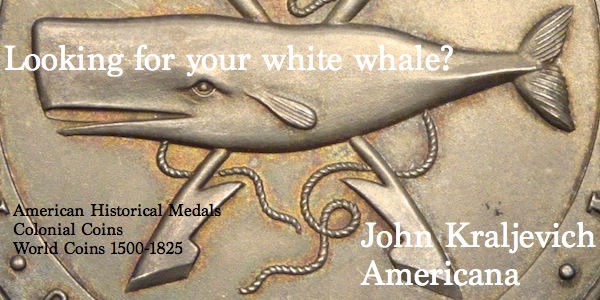
UKRAINE INTRODUCES MONEY MADE OF FLAX
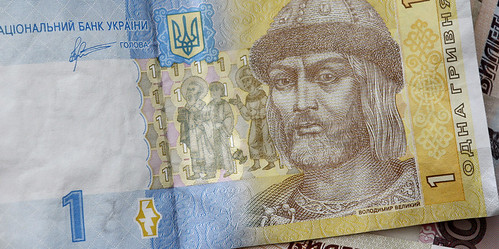
In Ukraine, new hryvna banknotes will be made of flax, described by National Bank as a more durable material already used in dollar notes. It is as of yet unclear if this will make the ailing hryvna sturdier as a currency. Ukraine’s National Bank (NBU) said in its press release that new hryvna banknotes will be made of flax fiber. Paper manufacturers, it added, have long been experimenting with other materials, such as cotton, but tapped flax because it was the cheapest option.
Other crops like paddy straw or banana fiber were also considered, according to NBU’s deputy director Yakov Smoliy.
Flax “has long been used to manufacture banknote paper for dollar bills in the US,” he said.
Introducing flax hryvna “will mark a new stage in the development of our national currency,” Smoliy added. He claimed that the new material would make banknotes more damage-resistant.
But it will likely take more than that to boost the hryvna’s value and exchange rate. The Ukrainian currency has been in constant nosedive over the last two years.
Flax is actually a food and fiber crop that is grown in cooler regions of the world. The textiles made from flax are known in the West as linen, and traditionally used for bed sheets, underclothes and table linen. To no surprise, the NBU’s statement mentions that the new innovation would “support domestic agricultural producers and create more jobs.”
To read the complete article, see:
Hand wash, dry flat? Ukraine introduces money made of flax
(www.rt.com/business/337377-ukrainian-money-hryvnia-flax/)
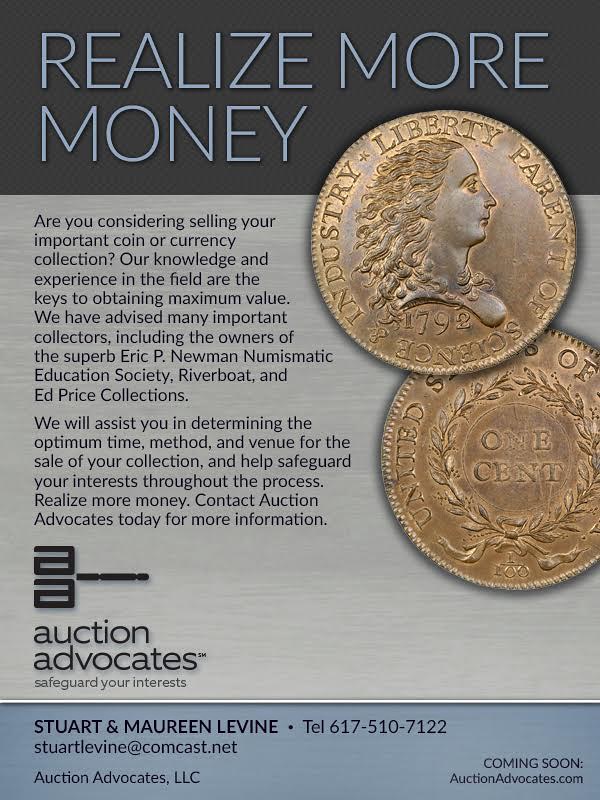
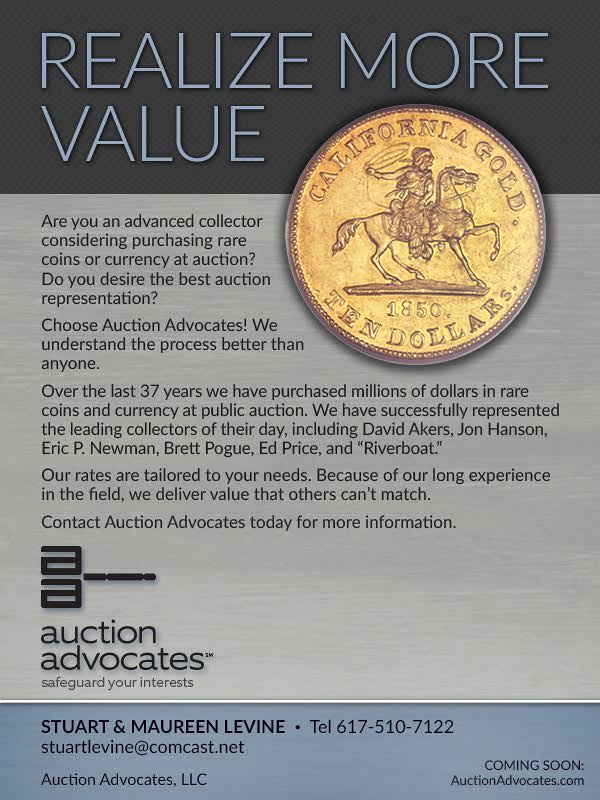
NANO-HOLES FOR BANKNOTE SECURITY
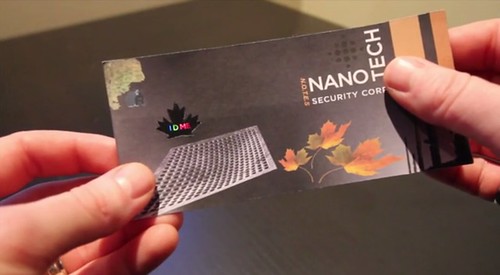
Nano-holes sound like science fiction. Yet, this sophisticated technology is very real, and might be making counterfeiting a whole lot more challenging. Nanotech Security (NTS: CA) is a security firm that uses nano-structured optics to control light to make clear codes and recognition images that can be embedded in thins like banknotes, passports, etc.
Many banknotes that have holographic imagery on them use a technology that has not been updated since the 1960s. Nanotech’s KolourOptik is cutting-edge and can be used with almost any material. The way it works is that nano hole are pressed onto a material and with an algorithm Nanotech creates color shifting affects that are not possible with holographic tech. This level of innovation has earned a Nanotech a development deal with a foreign government that is currently going into its third phase of testing (cited here). This highly confidential contract is supposedly worth $1 million.
Nanotech is currently working on two other development contracts and CEO Doug Blakeway talked about how unique this opportunity was in the most recent fiscal report: “These two development contracts are material achievements. Issuing authorities are paying us – something not common in the industry – to design unique banknote security features with our OTF and KolourOptik™ technologies.”
As these new banknotes appear and Nanotech’s security features are on full display, it will be interesting to see if this leads to more contracts, which most analysts believe is a given.
To read the complete article, see:
Nanotech Security Working with
Three Countries on Banknote Security (www.equities.com/news/nanotech-security-working-with-three-countries-on-banknote-security)
LABORATORY ANALYSIS OF STOLEN CURRENCY
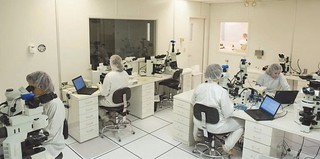 Improvements in scientific technology and technique have greatly expanded our ability to analyze microscopic samples for their composition,
source, and/or age. This has led to various applications, such as the study of chemical impurities, historical artifacts, and crime scene evidence.
Although the surface and interior composition of coins has been studied to help determine their history and legitimacy, little similar work has been
done on currency. We report here on our laboratory analysis of stolen currency to confirm its well-documented history and to demonstrate the
potential for future studies on other currency.
Improvements in scientific technology and technique have greatly expanded our ability to analyze microscopic samples for their composition,
source, and/or age. This has led to various applications, such as the study of chemical impurities, historical artifacts, and crime scene evidence.
Although the surface and interior composition of coins has been studied to help determine their history and legitimacy, little similar work has been
done on currency. We report here on our laboratory analysis of stolen currency to confirm its well-documented history and to demonstrate the
potential for future studies on other currency.
An accompanying article in this issue details the 1866 robbery of the Osage National Bank of Osage, IA, charter #1618. In brief, the door of the bank safe was blown off with gunpowder and among the stolen currency were crisp, unsigned, unissued $5 Original Series notes from the bank with serial numbers 1751 through 2200. The thieves forged the bank officers' signatures and distressed the notes before starting to pass them. Sixteen of the stolen notes have survived, mostly in tattered and torn condition. On the note pictured here, the stamped letter “S” is faintly visible in blue ink in several places to indicate its having been stolen.
Laboratory Procedure
We studied two of the Osage stolen notes, serial numbers 1966 B (pictured here) and 1951 A (pictured in the accompanying article).
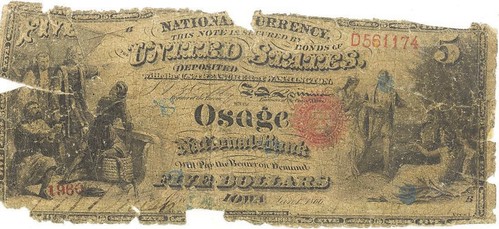
Both notes had been purchased from prominent numismatic sources. Our goal was to determine whether we could obtain evidence confirming their presence in the explosion of the bank safe. We looked for three different microscopic materials embedded on the surface of the notes. First, gunpowder residue may have survived the explosion. Next, a local newspaper reported that a roll of stolen currency recovered from the thieves was covered with “Plaster Paris.” This white powder was undoubtedly a proprietary fire-proofing material with which manufacturers of bank safes typically lined the safe walls, such as talc, asbestos, or gypsum. Finally, iron fragments would be strong evidence of an explosion.
In summary, we have found three separate lines of evidence compatible with an origin in an explosion in a bank safe (iron oxide particles formed in a high temperature event, talc as a fire-proofing agent, and trace elements from gunpowder residue). These findings are somewhat speculative, and none are definitive. And of course we can not know how the notes may have become soiled or contaminated during the last 150 years. But we can say that our results are consistent with the robbery that was so well documented in 1866.
We have demonstrated that modern, non-destructive laboratory analysis can provide information about currency not available in any other way. A wide variety of other technological methods are available in addition to those we have used. Perhaps special applications may be found for the study of certain paper, ink, counterfeits, DNA, etc. Researchers need to include these possibilities in their thinking.
For more information about the Society of Paper Money Collectors, see:
www.spmc.org
THE BOOK BAZARRE
AN OTTOMAN COIN EMBOSSED POSTCARD
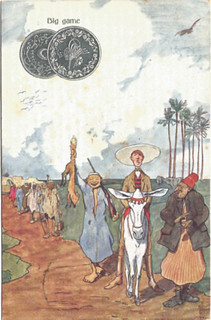
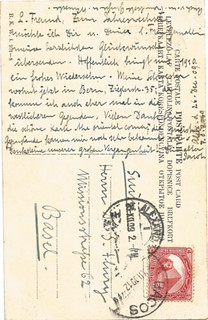
Nureddin Gürpinar writes:
I live in Istanbul and collect Embossed Coin Postcards exclusively belonging to Ottoman (Turkey) & Egypt only. Attached please find the scanned picture of a card “ Big game” printed/published by Brüder Kohn, Vienna. It has also been used postally and sent from Alexandria, Egypt to Basel, Switzerland on 26.12.1909.
Two weeks ago at an auction in Istanbul I saw this card, attracted my attention and purchased. Because it had “embossed picture of an old Ottoman coin”, it was almost in line with my collection subject.
I would like to learn if any other postcards issued by B.K.W.I which also had similar “embossed coin figures” on them like the one here. Most likely someone amongst your subscribers may provide me more info about these “embossed coin“ BKWI cards.
To read some earlier E-Sylum articles, see:
COIN CARD POSTCARD ALBUM CENSUS (www.coinbooks.org/esylum_v17n02a29.html)
MORE ON NUMISMATIC POSTCARDS AND ALBUMS
(www.coinbooks.org/esylum_v17n03a12.html)
MORE ON NUMISMATIC POSTCARDS (www.coinbooks.org/esylum_v17n04a19.html)
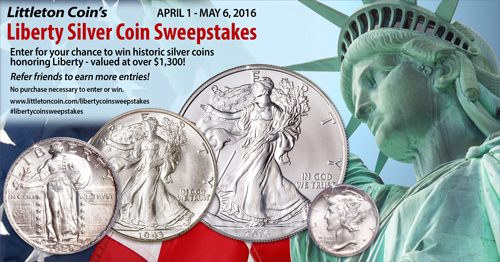
PUNCH-MARKED COINS IN INDIA
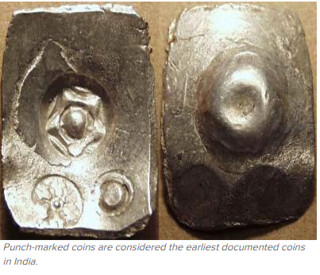 Chennai: When the barter system lost credibility in ancient times, a uniform currency system came into being. But checking the weight and
purity of the metal used for this purpose required technical expertise. To overcome the problem, an authentication mark was stamped on the piece of
metal to promise that it had adequate purity and weight.
Chennai: When the barter system lost credibility in ancient times, a uniform currency system came into being. But checking the weight and
purity of the metal used for this purpose required technical expertise. To overcome the problem, an authentication mark was stamped on the piece of
metal to promise that it had adequate purity and weight.
The next step was to decide the authority who could assign these guarantee marks on the metal piece. Eventually, the ruling king of the concerned territory was given power to issue coined money.
Punch-marked coins are considered the earliest documented coins in India, according to P V Radhakrishnan, curator at RBI Monetary Museum, Mumbai. "These coins are mostly made of silver, and bear various symbols, each of which is punched on the coin with a separate 'punch'. The date generally accepted for these coins is the beginning of the 6th century BC," he said, while speaking on "Significance of the symbols on ancient Indian coins and un-inscribed coins of Tamil Nadu from 500 BC to AD 300," at the department of ancient history and archaeology, University of Madras, on Wednesday.
The scholars who studied this series classified them into two groups, local and universal. "The local punch-marked coins generally carry one, two or four symbols and were issued in different weight standard, fabric and execution, varying in different regions or localities. These coins are ascribed to various small and large states (janapadas and mahajanapadas), many of which existed in India from early times," he said.
The imperial punch-marked coins, according to Radhakrishnan, uniformly bore five symbols. These coins were issued first by the Magadha dynasty when it was still a janapada. Gradually, Magadha extended its dominions by annexing neighbouring states and became a powerful monarch. "By the time of Ashoka, the Magadhan empire had spread over most of the Indian subcontinent. Its coins also spread with the empire's expansion and have been found in large numbers across the length and breadth of the Mauryan Empire, from Western Afghanistan to today's Bangladesh, and from the Himalayan foothills to the Deccan. The silver punch-marked coins also travelled beyond the Mauryan territory to the Chera, Chola and Pandya kingdoms of South India and to Sri Lanka due to the spread of Buddhism and extensive maritime trade," he said.
To read the complete article, see:
How
Punch-Marked Coins Replaced Barter System
(http://timesofindia.indiatimes.com/city/chennai/How-punch-marked-coins-replaced-barter-system/articleshow/51623892.cms)


